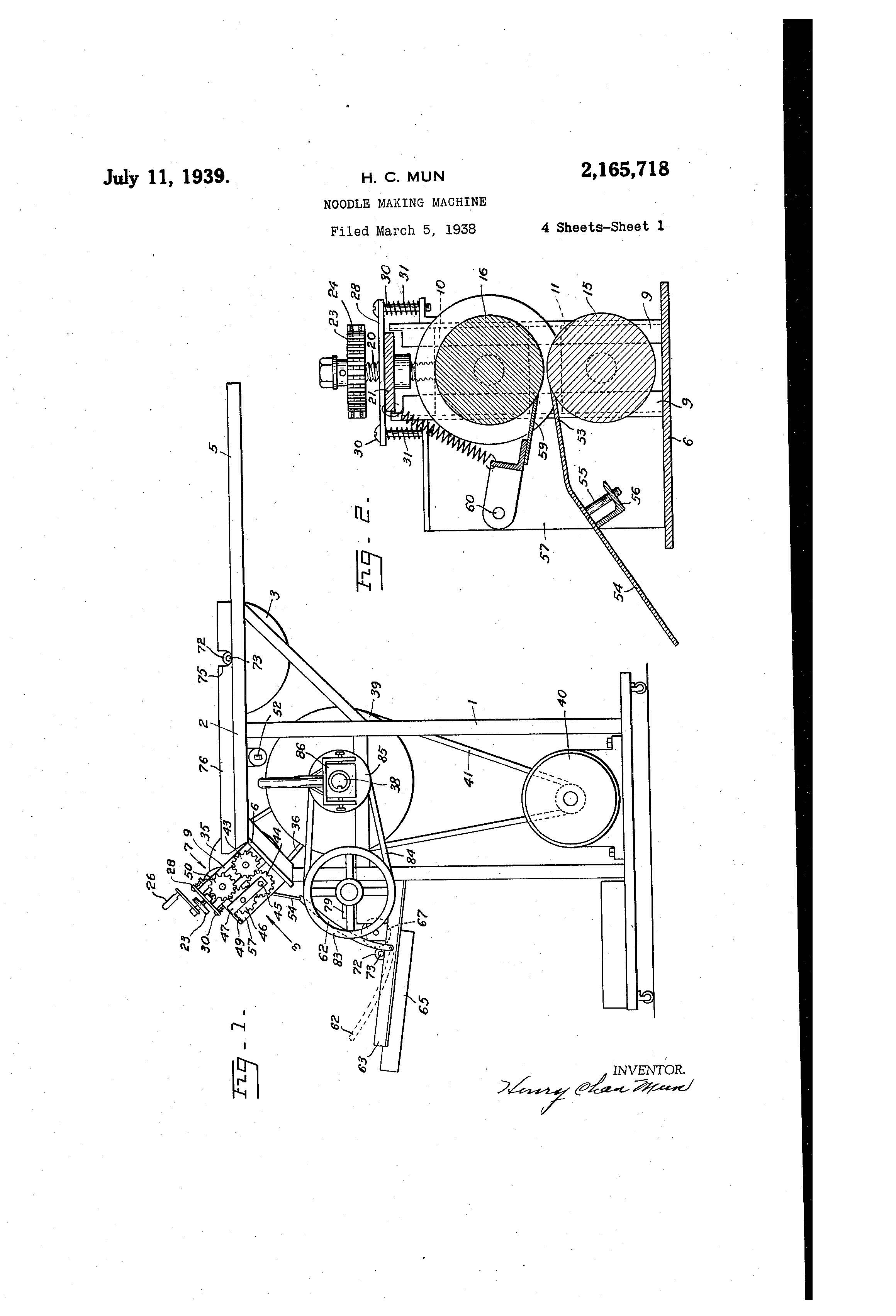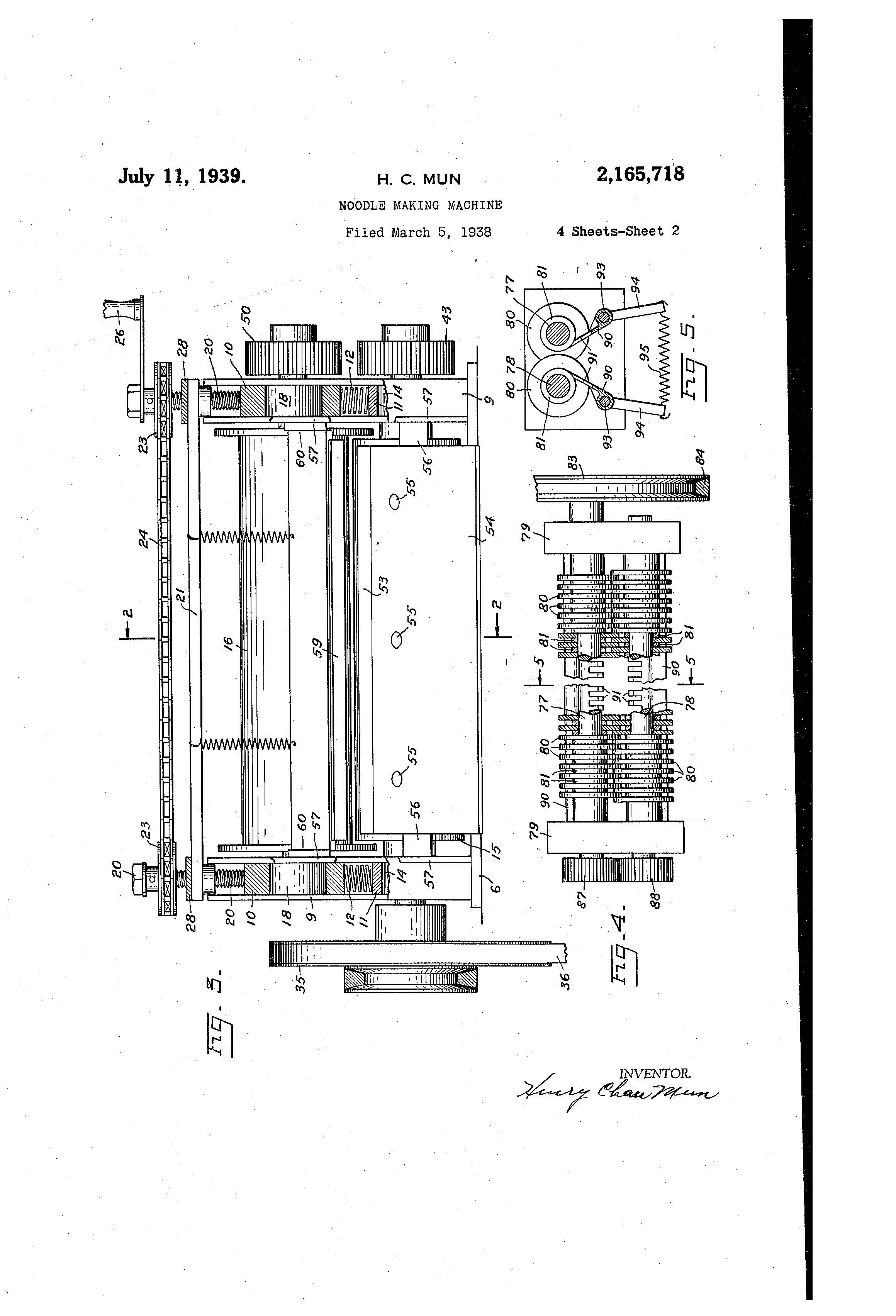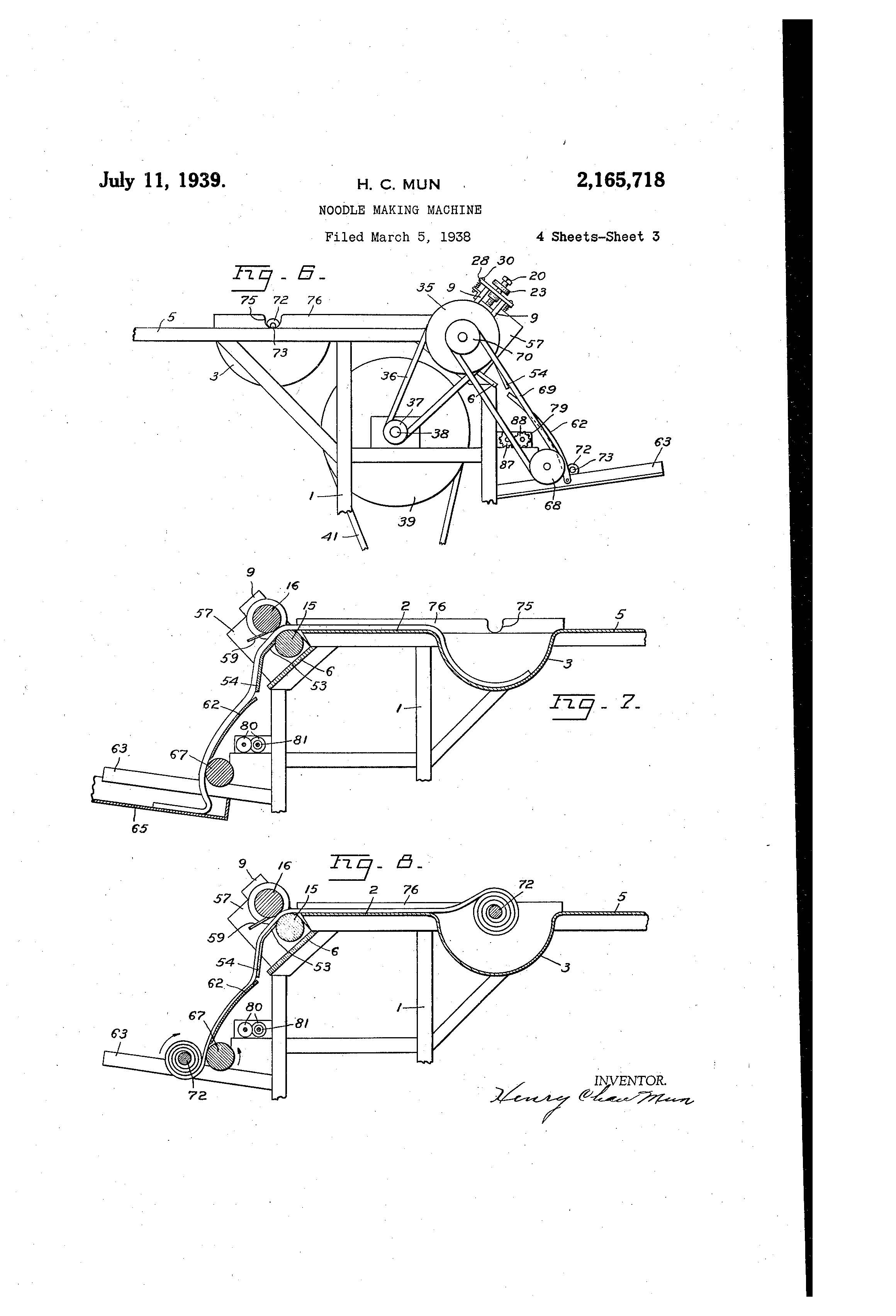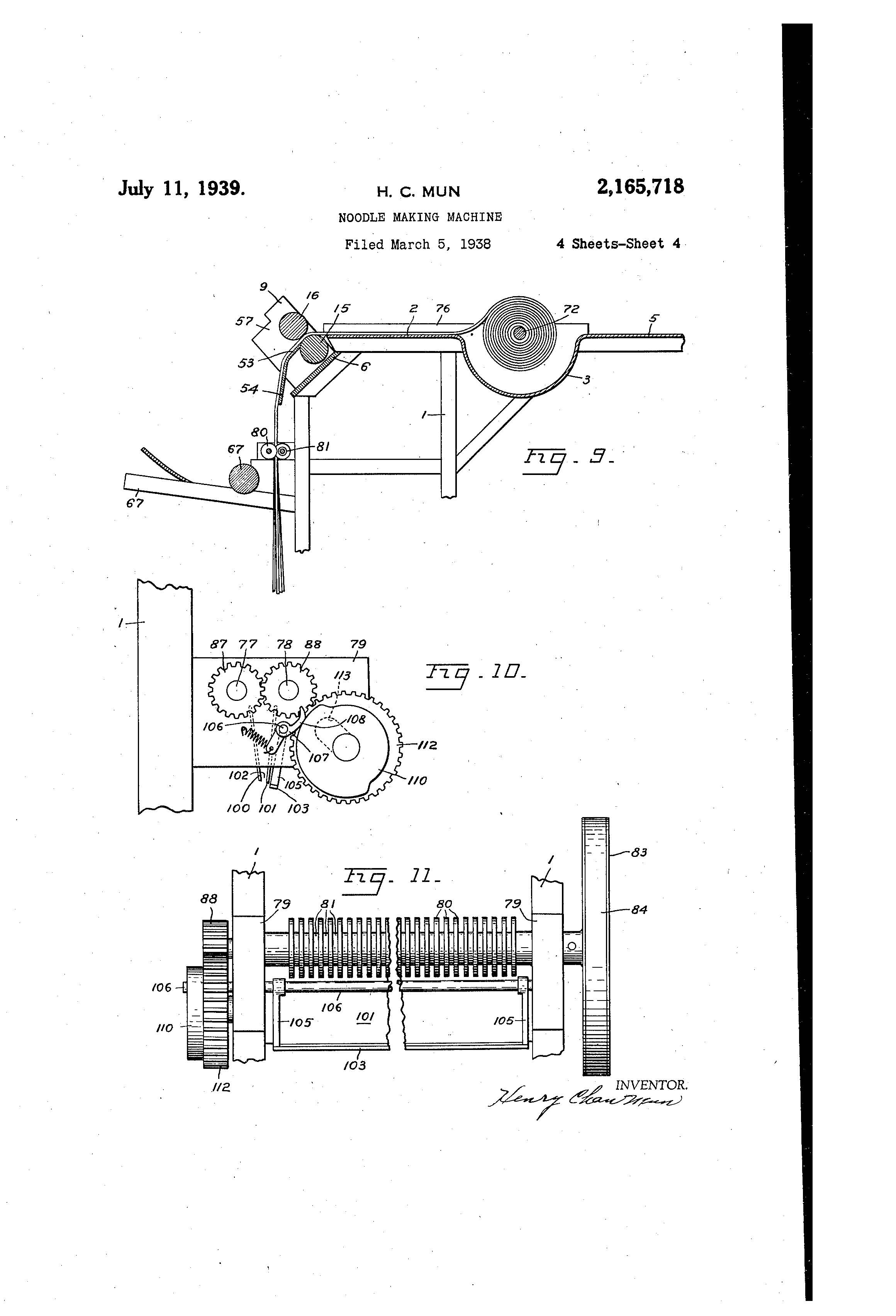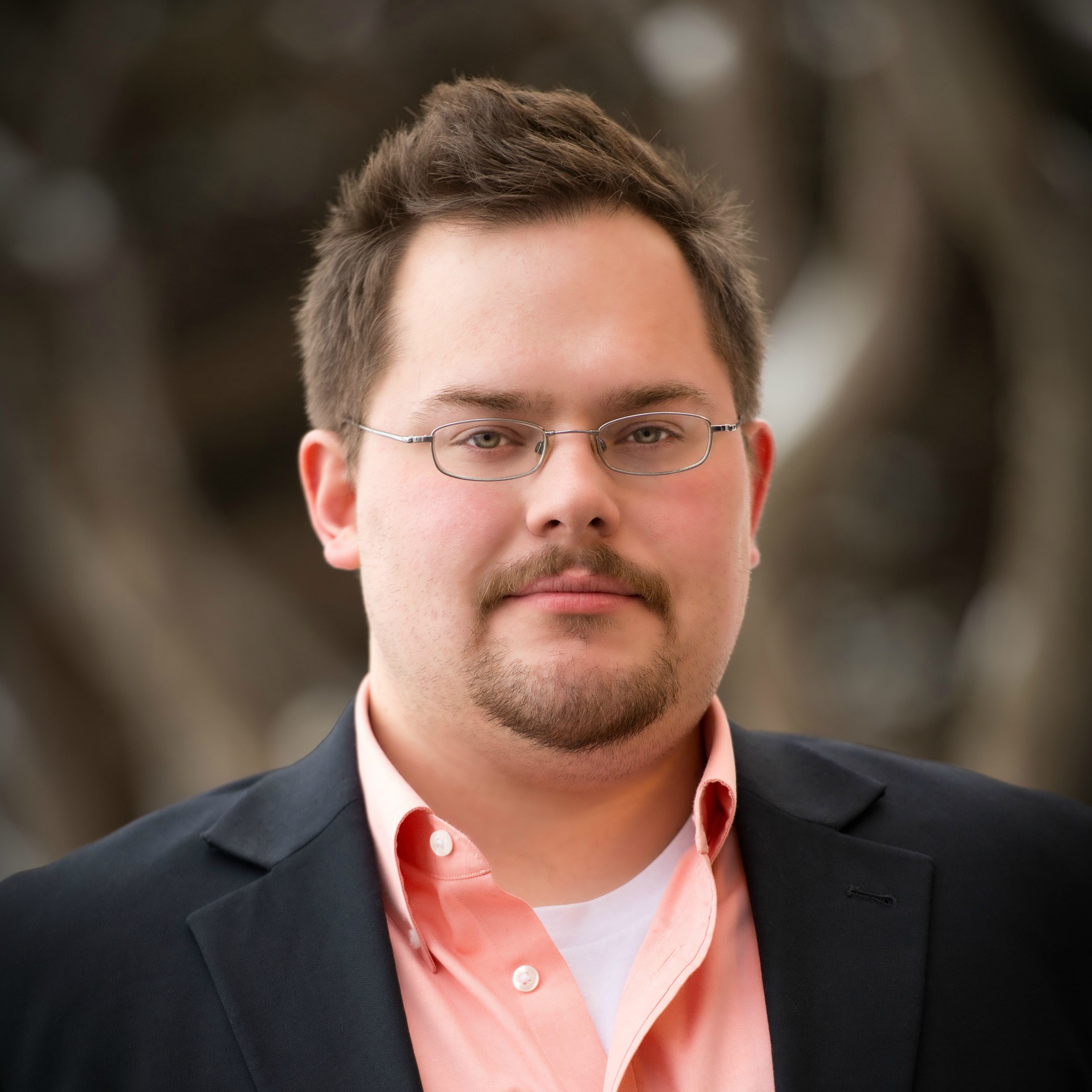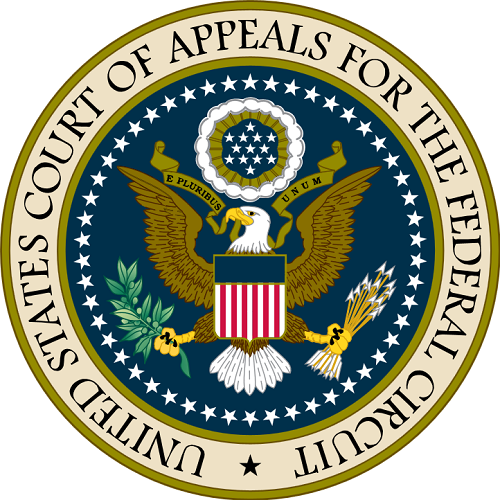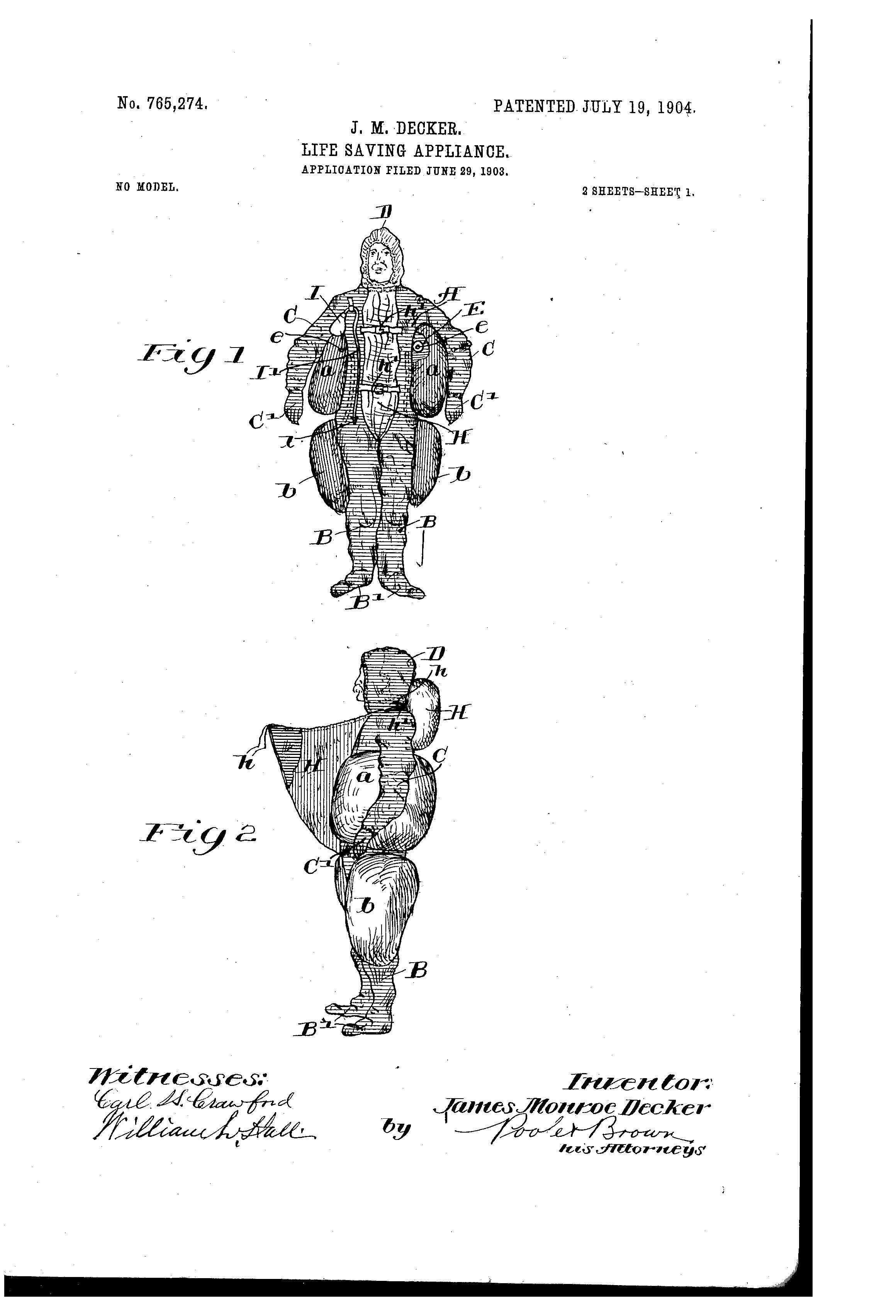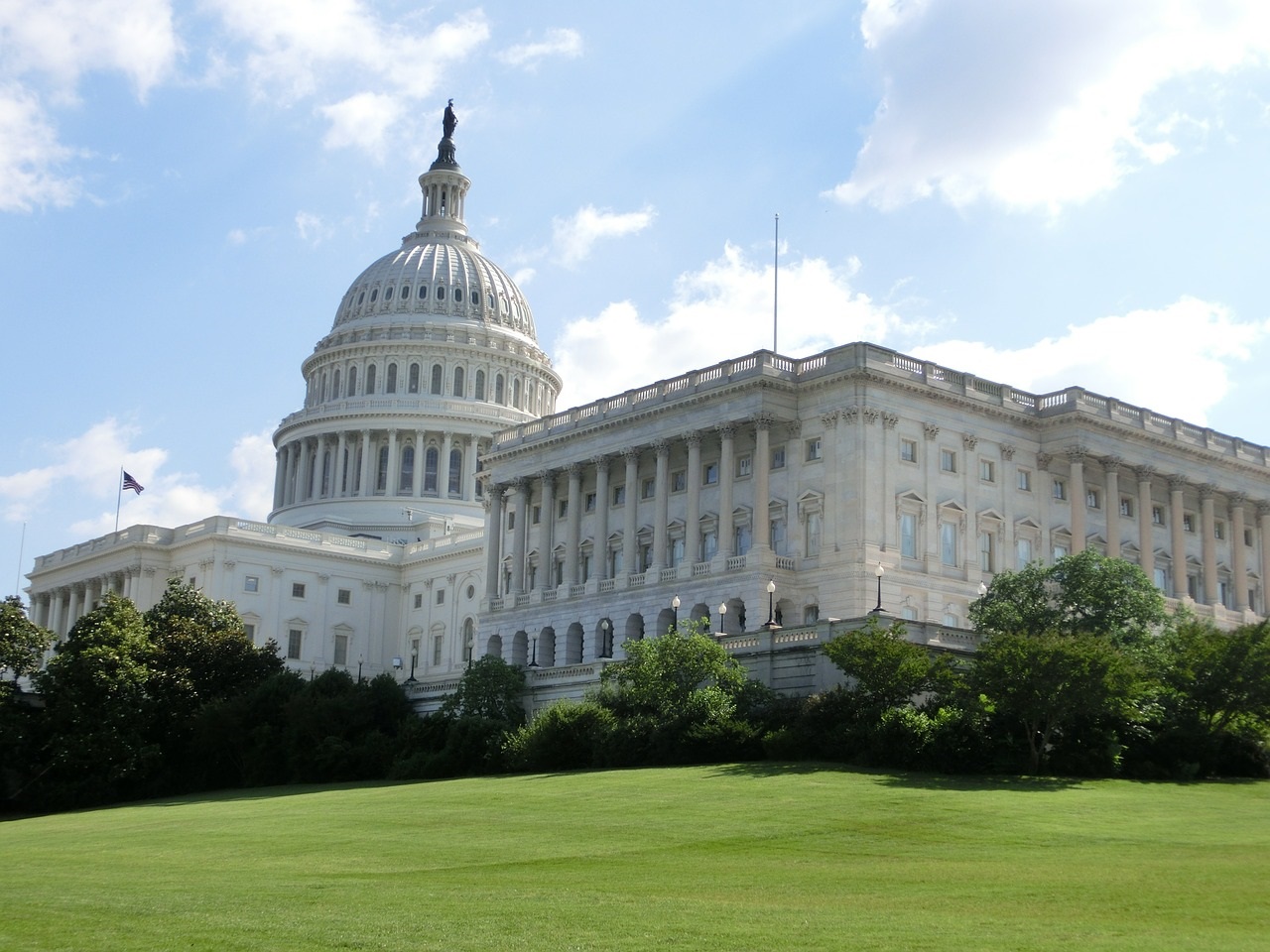Suiter Swantz IP Team Spotlight: Jon S. Horneber
At Suiter Swantz IP, we take great pride in providing our clients with the highest level of intellectual property representation and we recognize this would not be possible without our elite team of patent attorneys and staff. Each month we feature one of our team members and give you the opportunity to learn more about their experiences and background. This month it is our pleasure to introduce Jon Horneber.
Jon S. Horneber is a patent attorney with Suiter Swantz IP and holds B.S. and M.S. degrees in Mechanical Engineering from the University of Colorado Boulder. Jon received his Juris Doctor from the University of Nebraska. Jon joined the Firm as a law clerk in 2014 and, after graduating law school, began working as a patent attorney in 2016.
Outside the office, Jon enjoys outdoor activities such as hiking, camping, and hunting; frequenting breweries and distilleries; working on his cars and motorcycles; and improving his musical abilities.
How did you get into patent law?
My parents are attorneys, so I always had a connection to the law. During junior year of college, I considered alternative options to entering the workforce as an engineer and it all sort of came together.
What is one of the biggest challenges you’ve faced professionally?
The Registration for Examination with the United States Patent and Trademark Office (AKA the Patent Bar Exam). The Uniform Bar Exam to become an attorney was certainly difficult, but it was difficult for all of us who took it at that time, so we could help each other through the low points. In contrast, one is generally on their own for the Patent Bar Exam—it was a real test of self-discipline.
Where did you grow up?
I once called Sioux City home, and have parents who are considerably more versed in the art of being an attorney than I.
What do you like to do outside of the office?
I enjoy working on my vehicles; playing and listening to music; attending sporting events and board game events; frequenting breweries and distilleries; and outdoor activities such as hiking, camping, and hunting.
What is your favorite book, movie, song/artist/group?
I cannot say I have a favorite that immediately comes to mind. I read what interests me—when it interests me I practice and listen to various genres of music depending on my mood.
Patent of the Day: Inflatable Boat
Suiter Swantz IP takes a look back at past inventions and inventors with our Patent of the Day.
On this day in 1967, Giacarlo Mambretti filed an application for U.S. Patent No. 3,453,671 for a INFLATABLE BOAT.
An excerpt from the patent states:
An inflatable boat adapted to be driven by an outboard motor. An inflatable float is provided in the form of an elongated tubular body made of a suitable plastic and forming an envelope by which the bow and sides of the boat are formed. A rigid transom, to support the outboard motor, is situated adjacent the stern end of the boat. A plastic strip is welded to the tubular body at the region of its stern end and is formed with grooves which receive edges of the transom, the latter being secured to the strip by being welded thereto. An oarlock is welded to the envelope and has an upper projection formed with an elongated bore having a minor axis extending vertically and having a length no greater than the diameter of an oar while the major axis of the bore extends horizontally and is larger than the oar diameter to provide for free movement of the oar in the bore. A seat is in the form of an elongated board having teeth at its opposed ends, and at each side of the envelope there is welded thereto a flange which surrounds a support in the form of a hollow body subdivided by partitions into recesses which receive the teeth at an end of the board so as to support the latter.
Suiter Swantz IP is a full-service intellectual property law firm, based in Omaha, NE, serving all of Nebraska, Iowa and South Dakota. If you have any intellectual property questions or need assistance with any patent, trademark or copyright matters and would like to speak to one of our patent attorneys please feel free to contact us.
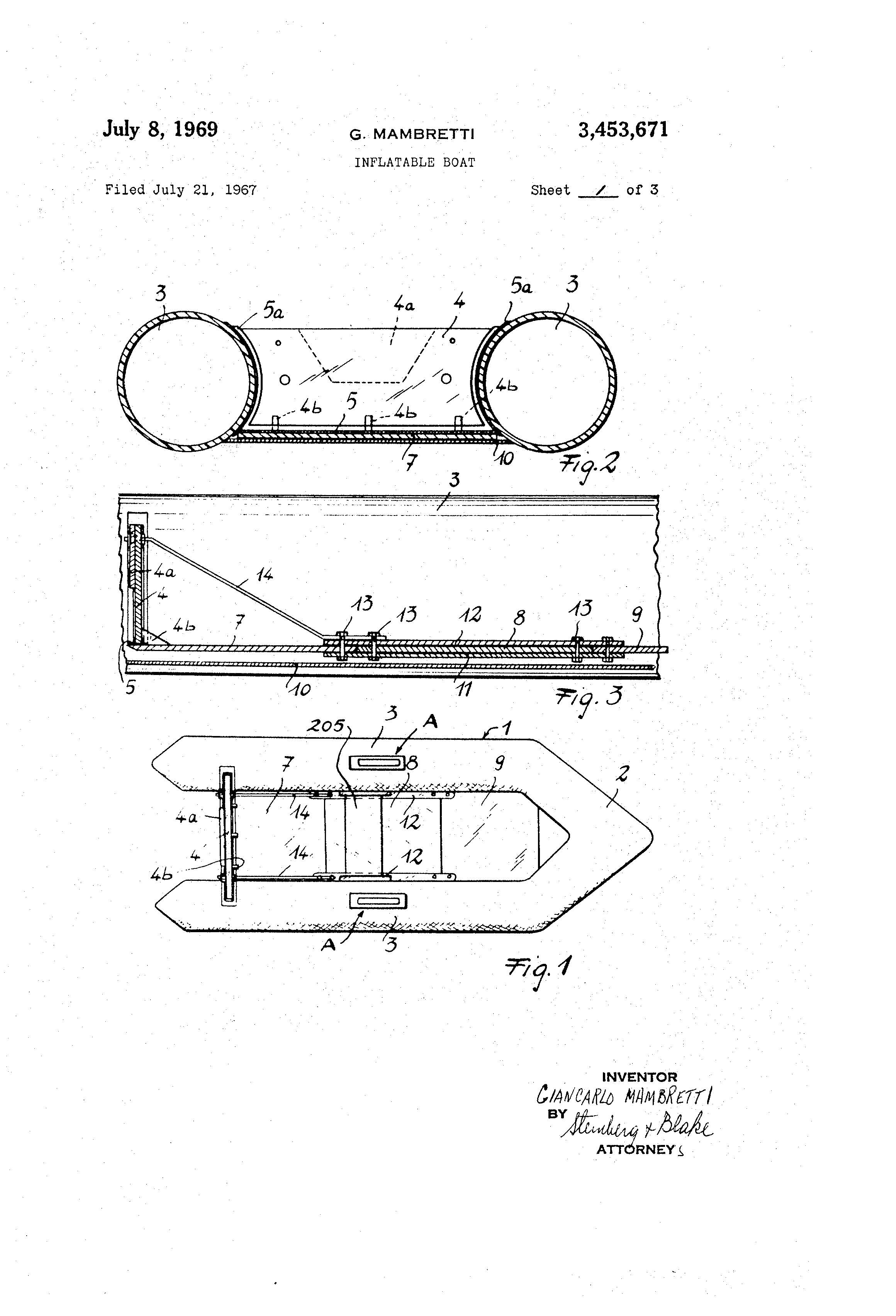


Motion to Amend in an IPR Defeated in the CAFC
In the recent case Shinn Fu vs. Tire Hanger, No. 16-2250 (Fed. Cir. 2017), decided on July 3, 2017, the United States Court of Appeals for the Federal Circuit (“CAFC”) vacated a Patent Trial and Appeal Board (“Board”) decision (Decision No. IPR2015-00208) which granted Tire Hanger’s motion to amend in an inter partes review (“IPR”). In vacating the decision, the Court reasoned that the Board did not “properly consider the arguments petitioner set forth in its opposition to the patent owner’s motion to amend.” By reasoning that the Board did not properly consider the petitioner’s arguments, the Court vacated the grant of the motion to amend.
As Troy discussed in his previous blog post article, The Supreme Court to Determine the Constitutionality of Inter Partes Reviews, the IPR was first introduced by the Leahy-Smith America Invents Act (“AIA”) on September 16, 2012. At a general level, an IPR is a trial proceeding conducted by the Board which allows any third party to challenge the patentability of an issued patent. A third party may initiate an IPR by filing a petition within nine months of the issuance of a patent, and may challenge the validity of the patent based on a lack of novelty (§ 102) or obviousness (§ 103).
Under the AIA, patent owners are permitted to file a motion to amend the claims of a patent during an IPR. However, a motion to amend during an IPR has proved not be a viable approach for patent owners. This is largely due to a lack of guidance. In fact, Shinn Fu vs. Tire Hanger was only the sixth time that the Board had granted a motion to amend since the IPR became available in 2012.
In the instant case, Tire Hanger holds U.S. Patent No. 6,681,897 (“the ’897 patent”), which generally relates to “apparatuses and methods for handling and supporting vehicle wheels that have been temporarily removed from a vehicle positioned on a lift or hoist.” The apparatuses and methods embodied in the ‘897 patent allow an auto mechanic to remove and/or replace a wheel without having to bend over.
Shinn Fu filled a petition for IPR of claims 1-5 of the ‘897 patent, arguing that the claims of the ‘897 patent were invalid as being anticipated or obvious. After the IPR was instituted, Tire Hanger filed a motion to amend substituting claims 6-10 for the original claims 1-5. The Board granted the motion to amend in 2016, finding the substitute claims to be patentably distinct over the prior art of record.
In its decision to grant the motion to amend, the Board laid out a couple of important guidelines for patent owners seeking a motion to amend during IPR.
First, the Tire Hanger decision seems to alleviate the burden of showing patentability of the amended claims by relaxing the burden requiring patent owners to address all prior art of record. The Board stated that “[a] patent owner meets its duty of condor and good faith by grouping prior art references together according to their particular teachings without having to make a presentation on each and every reference giving rise to that same teaching.” In other words, given that the patent owner addresses prior art references that were grouped together according to their particular teachings, a patent owner does not have to address all prior art of record separately.
Second, the Tire Hanger decision seems to alleviate the evidentiary burden exerted on patent owners when filling a motion to amend. The Board stated “Tire Hanger did not file an expert declaration with its motion to amend, relying instead on express disclosures on the prior art and the challenged patent as evidence of the level of skill in the art.” Though a successful establishment of obviousness or non-obviousness in AIA proceedings most often requires expert declarations, by granting the motion to amend without an expert declaration, the Board in Tire Hanger demonstrated that expert declarations are not always required. Indeed, the Tire Hanger decision is an example of where a patent owner successfully established the non-obviousness of the proposed claim amendments in a motion to amend without an expert declaration.
Third, the Tire Hanger decision seems to stress a reasonable interpretation of claim language in light of the specification and prosecution history. In their motion to amend, Tire Hanger added the term “human” to the claims. In response, Shinn Fu argued that the term “human” did not meet the written description requirement, as the specification of the ‘897 patent only referred to a “worker,” not a “human.” Shinn Fu stated that “Tire Hanger has broadened the claims to include ‘such embodiments or species as newborns, toddlers, children, disabled people, and decrepit people’”. After hearing the arguments, the Board held that Shinn Fu’s proposed construction was unreasonable, and that the proposed amendment of the claims met the written description support.
The Board’s decision granting the motion to amend was then appealed to the Federal Circuit. On appeal, Shinn Fu argued that the amendment of the claims proposed by Tire Hanger simply involves the combination of prior art including Curran (U.S. Patent No. 4,976,336) and Conrad (U.S. Patent No. 4,650,114). Shinn Fu further provided what it believed to be the motivation to combine the prior art.
Following arguments on appeal, the Court noted that “the Board did not provide any analysis with regard to the manner in which Shinn Fu proposed its key obviousness combination.” The Court went on to state that “[w]e have no meaningful way to review the Board’s patentability determination in light of Shinn Fu’s arguments.” In doing so, the Court vacated the Board’s order granting Tire Hanger’s motion to amend, and the case was remanded to the Board for further proceedings.
While many in the patent community would have hoped the Tire Hanger case would act as a leading guideline for a successful motion to amend, such a thought may prove to be just that: too hopeful. The Tire Hanger decision appears to have laid out guidelines with respect to motions to amend during an IPR, but only time will tell how those guidelines will be applied or whether the opinion will clarify the rules.
Suiter Swantz IP is a full-service intellectual property law firm based in Omaha, NE, serving all of Nebraska, Iowa, and South Dakota. If you have any intellectual property questions or need assistance with any patent, trademark, or copyright matters and would like to speak to one of our patent attorneys please feel free to contact us.
Patent of the Day: Ice Cream Freezer
Suiter Swantz IP takes a look back at past inventions and inventors with our Patent of the Day.
On this day in 1897, Charles H. Ackerman was granted U.S. Patent No. 586,538 for an ICE-CREAM FREEZER.
An excerpt from the patent states:
My invention relates to improvements in that class of ice-cream freezers known as "instantaneous" in which the cream is frozen while being forced or conveyed through a refrigerating-chamber.
The objects of my invention are, first, to render the refrigeration more effective by increasing the contact of the freezing mixture with the cream-tube; second, to provide means for thoroughly working or stirring the cream while it is being frozen; third, to provide means for feeding the cream either constantly or intermittently to the cream or freezing tube, and, fourth, to provide for intermittently feeding the freezing mixture to the ice-chamber.
The object of forming the conveyer with sectional screw-flanges is to render the movement of the cream intermittent thus giving it time to freeze and also causing it to be more thoroughly worked before reaching the outlet.
I attach great importance to the fact that the ice chamber is made to revolve about the conveyer, as the ice is thereby kept packed against the cream-chamber on all sides and the refrigeration rendered much more rapid, also to the peculiar construction of the conveyer, in that it is provided with the broken or sectional screw-flanges ad given a reciprocal longitudinal movement, as a much finer grade of cream is thus produced than by any other method.
Suiter Swantz IP is a full-service intellectual property law firm, based in Omaha, NE, serving all of Nebraska, Iowa and South Dakota. If you have any intellectual property questions or need assistance with any patent, trademark or copyright matters and would like to speak to one of our patent attorneys please feel free to contact us.
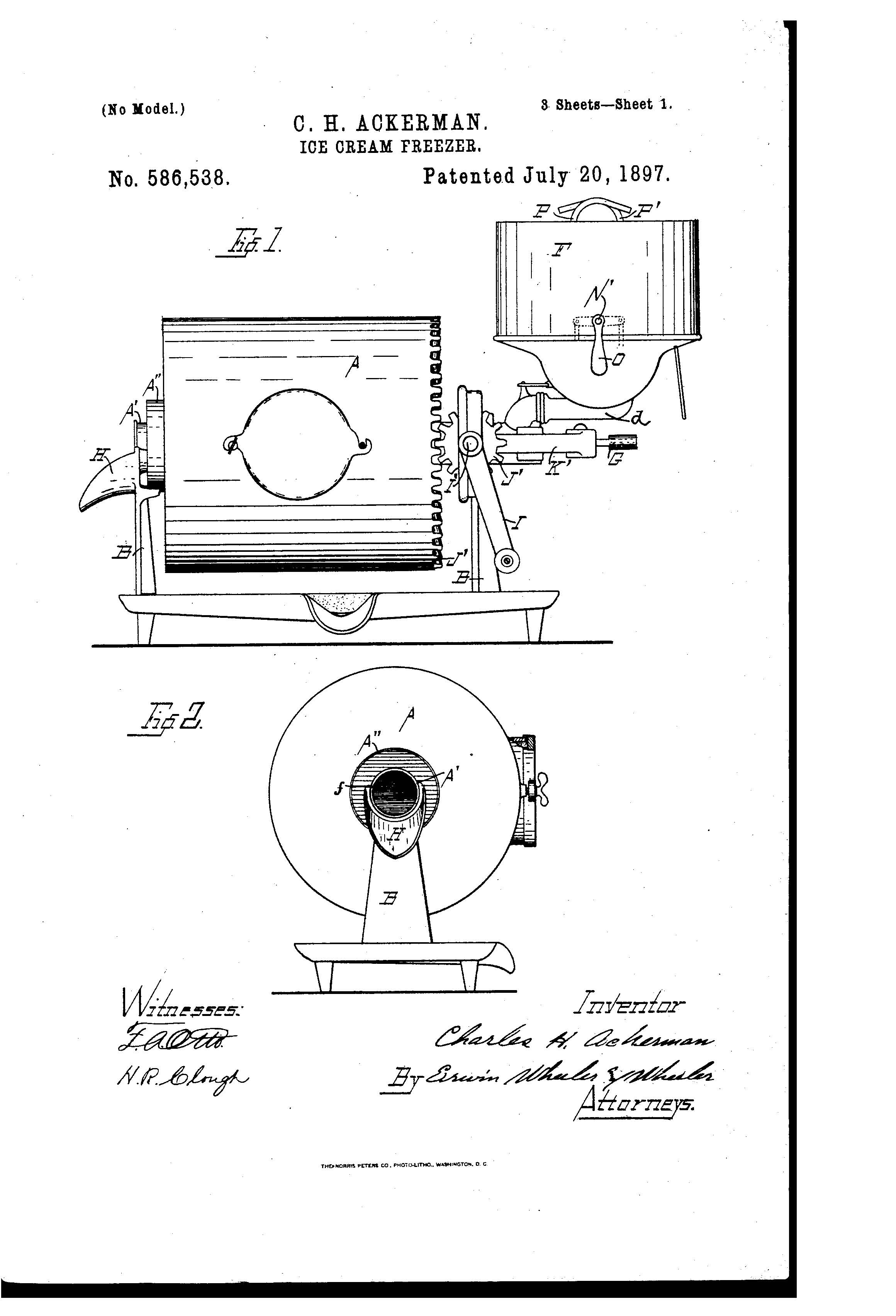
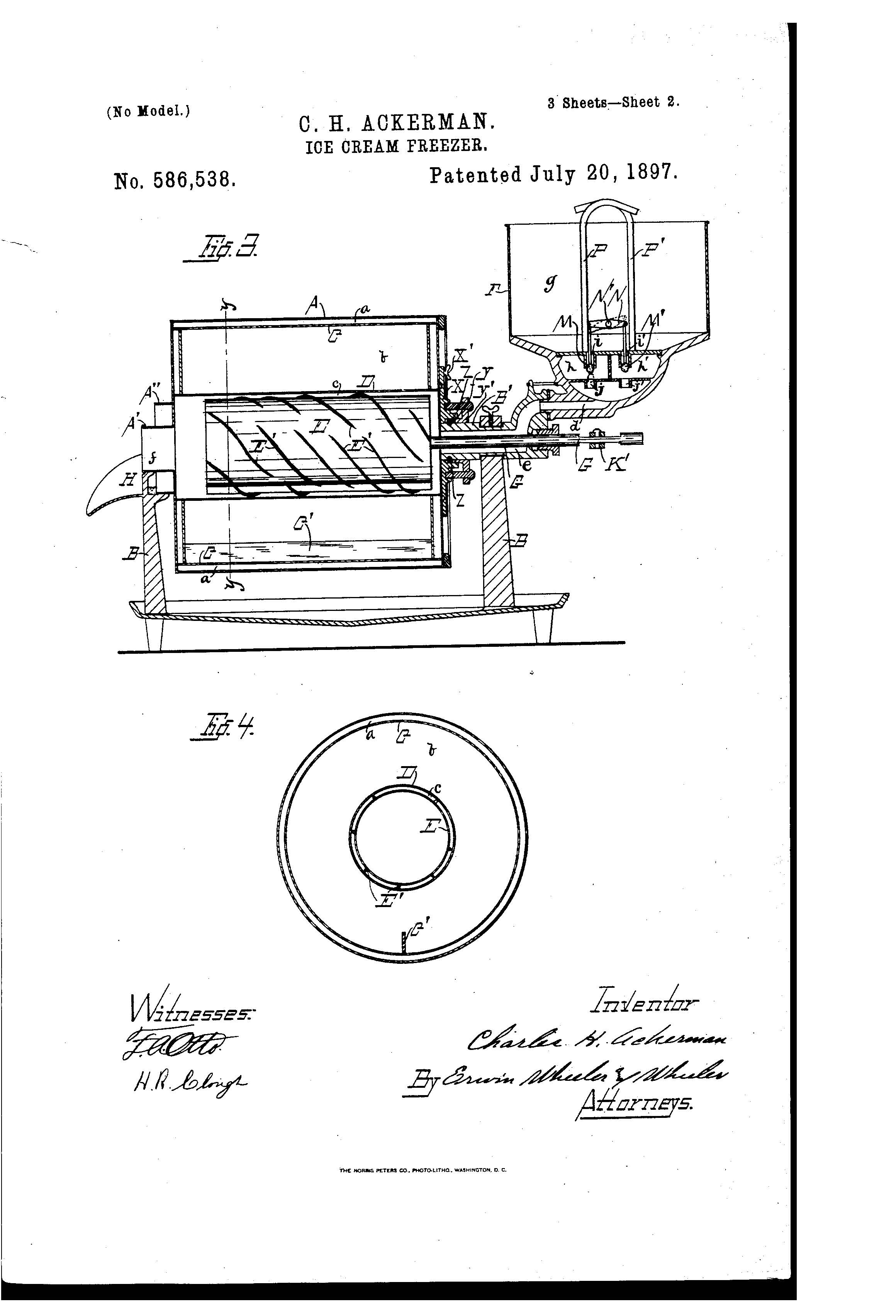
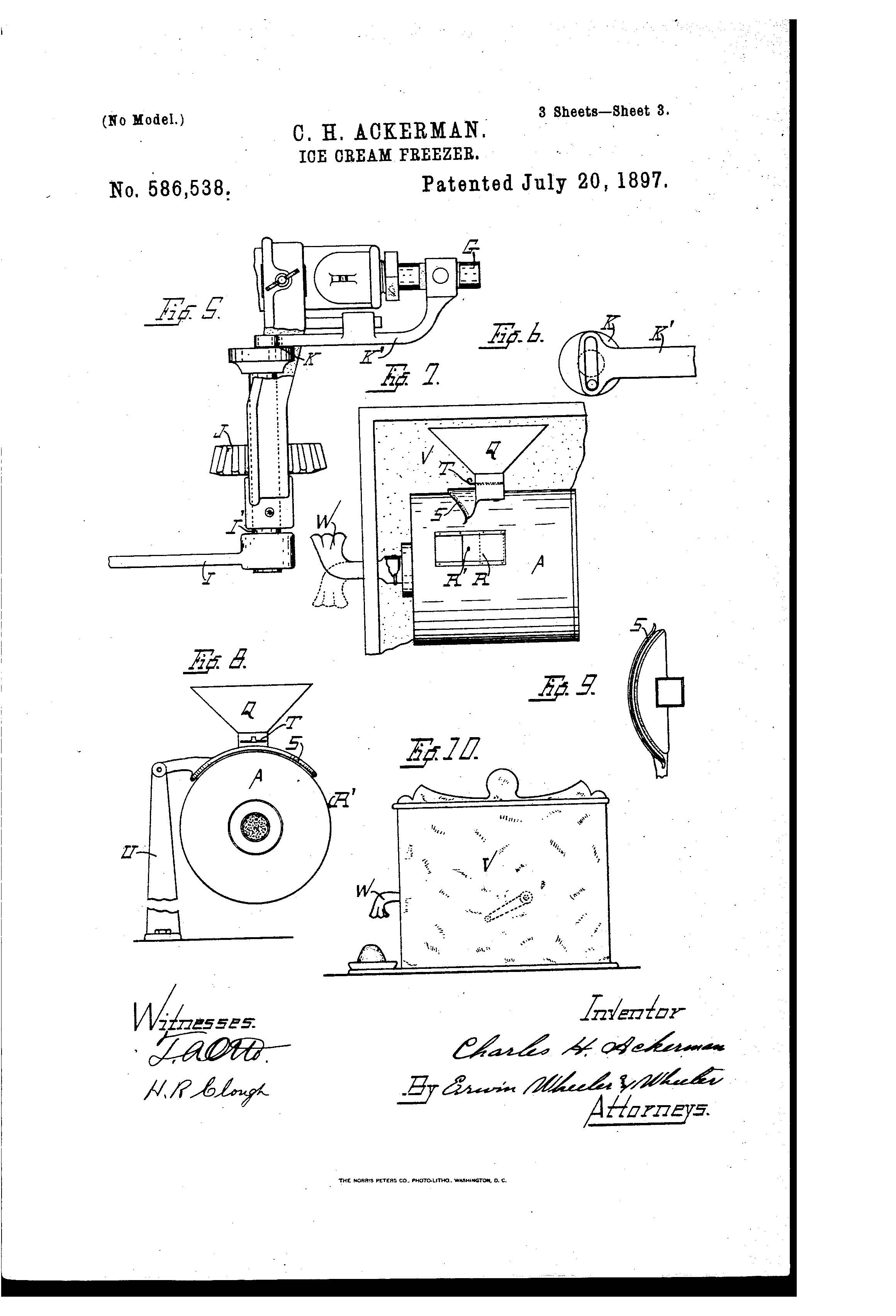
Patent of the Day: Life-Saving Appliance
Suiter Swantz IP takes a look back at past inventions and inventors with our Patent of the Day.
On this day in 1904, James Monroe Decker was granted U.S. Patent No. 765,274 for a LIFE-SAVING APPLIANCE.
An excerpt from the patent states:
I claim as my invention- 1. A life-saving appliance, comprising a suit made to cover the body, limbs and head, and provided at its front with an opening closed by buttons or the like, means for preventing the water from entering the suit at the front opening, pockets in said suit, airbags in said pockets and means for inflating said air-bags.
2. A life-saving appliance comprising a continuous suit made to cover the body, limbs and head, and provided at its front with an opening closed by buttons or the like, means for preventing water from entering the suit at the front opening, and inflatable air-bags attached to the suit.
3. A life saving appliance comprising a suit made to cover the body and limbs and provided with a hood or head-piece which fits closely over the head and with a collar just below said hood or head-piece which is capable of being opened at its front and is provided with closing devices, the upper part of said suit being provided with an opening and means for closing said opening constructed to prevent the entrance of water therethrough.
4. A life-saving appliance comprising a continuous suit made to cover the body, limbs and head, a collar adapted to closely fit around the neck, said suit being provided at its front with an opening closed by buttons or the like, means for preventing the entrance of water through the front of the suit, pockets in said suit, airbags contained in said pockets and means for inflating said air-bags.
5. A life saving appliance comprising a suit designed to cover the body, limbs and the head and provided at its front with an opening which is closed by buttons or the like, a loose flexible front attached to its edges to the front of the body portion at each side of said front opening and adapted to be folded over said opening with the edges thereof drawn closely about the neck, and inflatable air-bags afiixed to said suit.
6. A life saving appliance comprising a suit designed to cover the body, limbs and head, inflatable air-bags affixed to said suit at the sides of the body portion and at the sides of the leg portions, nipples for the upper airbags opening outwardly therefrom through the front part of the suit, nipples for the lower air-bags, and tubes detachably connected at their lower ends with said nipples for the lower air-bags and extending upwardly inside the suit to points near the nipples for the upper air-bags and are there connected with nipples which extend outwardly through the front portion of the suit.
7. A life-saving appliance comprising a continuous suit designed to cover the body, limbs and head, pockets at the sides of the body portion and at the sides of the leg portions of the suit, air-bags contained in said pockets, nipples for the upper air-bags opening outwardly through the suit, nipples for the lower airbags and tubes detachably connected at their lower ends with said lower nipples, and which are in turn connected at their upper ends with nipples which open outwardly through the body portion of the suit near the nipples for the upper bags.
8. A life-saving appliance comprising a continuous suit made to cover the body, limbs and head, a collar adapted to closely fit around the neck, said suit being provided at its front with an opening closed by buttons or the like, means for preventing the entrance of water through the front of the suit, inflatable air-bags affixed to said suit at the sides of the bod portion and at the sides of the leg portions, ad an air-bag adapted to be detachably fixed to the upper part of the body portion of the suit to serve as a head rest or chest-rest.
Suiter Swantz IP is a full-service intellectual property law firm, based in Omaha, NE, serving all of Nebraska, Iowa and South Dakota. If you have any intellectual property questions or need assistance with any patent, trademark or copyright matters and would like to speak to one of our patent attorneys please feel free to contact us.

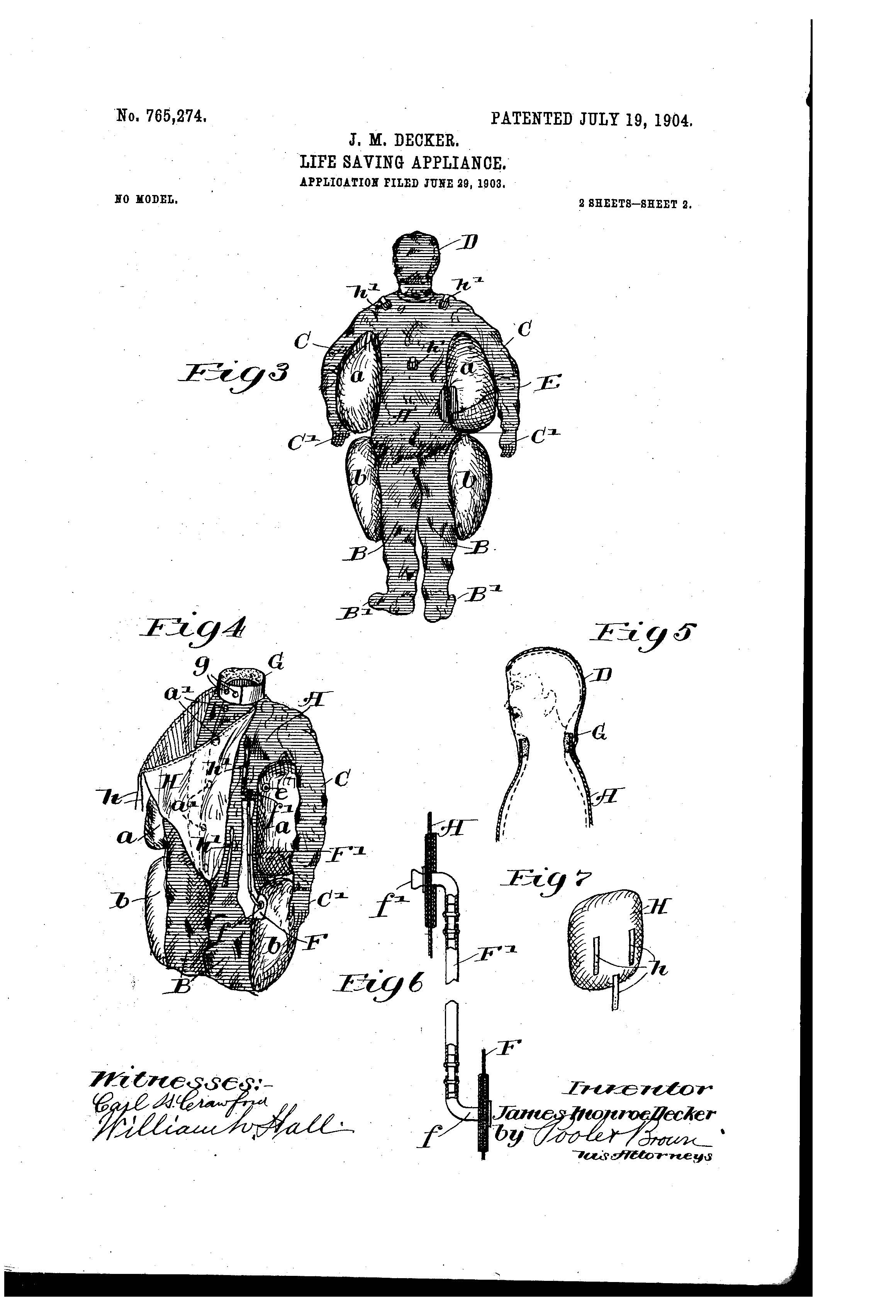
UC Davis Wins Strawberry Suit
Most people associate California with the beach and Hollywood. However, California is more than just a state with vacation spots and pop-culture. In fact, California is an agricultural giant, leading the country in farm income. The state grows over 200 crops, some of which are grown solely in California.
One of the highest grossing crops in the state is strawberries. As the fifth most valuable crop in the state, the small red fruit brings in an estimated $2.5 billion a year in California alone. The University of California Davis plays an important role in this revenue stream. Having patented fifty-six unique strawberry varieties since 1945, researchers at UC Davis have helped shape what is now the modern-day strawberry, developing strawberry strains that are larger, taste better, stay fresh longer, and yield six times more per acre. More than 80% of the strawberries grown in North America, and more than 60% worldwide, are UC Davis varieties.
Recently, multiple UC Davis strawberry patents were the center of a patent infringement suit brought in a San Francisco federal court. The University brought suit against two former employees alleging the former employees were infringing multiple UC Davis strawberry patents.
Defendants Douglas Shaw and Kirk Larson ran the UC Davis strawberry breeding program for twenty-two years until they retired in 2014. Before retiring, Shaw and Larson informed UC Davis they planned to form a private strawberry breeding company and sought a license from the University which would allow them to use UC Davis strawberries in their new business. The University rejected their proposal.
Despite the University’s rejection, Shaw and Larson proceeded to form the California Berry Cultivars (CBC) and to use UC Davis’ patented strawberries. Litigation ensued. UC Davis accused its former employees of violating their “duties of loyalty” to the university by taking some of the UC Davis plants to Spain, cross-breeding them, and bringing them back to California for commercial use. The University’s lawsuit, filed in 2016, claimed Shaw and Larson violated nine of their most successful strawberry patents.
During the trial, Stephen Dellaporta, a professor in Yale’s molecular, cellular, and developmental biology department, testified that CBC’s seedlings contained genetic material from five University-patented varieties that hadn’t been released at the time they were bred. Dellaporta further testified that nineteen unique varieties had never been released. Shaw acknowledged that some of CBC’s strawberry plants were bred from University-owned plants that had not been released commercially.
UC Davis further claimed that, in 2010, Shaw and Larson began sending varieties from its strawberry program to EuroSemillas, a Spanish company. Under prior agreements between UC Davis and EuroSemillas, University strawberry plants could be tested in Spain before going to market, but could not be used for breeding. However, the University claimed EuroSemillas harvested patented strawberry seeds in Spain and sent the seeds to CBC in United States for use, in violation of their agreements. The University claimed CBC and EuroSemillas bred the seeds in Spain and imported them into the US in an attempt to circumvent US patent laws.
After a five-day trial, the jury unanimously decided the two former researchers willfully infringed the University’s patented multi-million-dollar strawberry plants. The jury also found that the researchers used UC Davis’ un-patented plants without permission to breed strawberries through a private company that would have competed with the University.
In a prepared statement, Helene Dillard, Dean of UC Davis College of Agriculture and Environmental Sciences, said “[t]he federal jury decision is good news for public strawberry breeding at UC Davis and all strawberry farmers throughout California and the world. Our revitalized public strawberry breeding program will continue to develop affordable, high-quality varieties and train the next generation of breeders to serve every strawberry farmer, shipper, processor, and consumer.”
Suiter Swantz IP is a full-service intellectual property law firm based in Omaha, NE, serving all of Nebraska, Iowa, and South Dakota. If you have any intellectual property questions or need assistance with any patent, trademark, or copyright matters and would like to speak to one of our patent attorneys please feel free to contact us.
Patent of the Day: Folding Lunch-Box
Suiter Swantz IP takes a look back at past inventions and inventors with our Patent of the Day.
On this day in 1916, Myron A. Gilman was granted U.S. Patent No. 1,191,688 for a FOLDING LUNCH-BOX.
An excerpt from the patent states:
My invention relates to improvements in lunch-boxes of the folding type, and consists of an exterior collapsible shell and an interior folding box which is removable, both being of peculiar construction, as hereinafter set forth. The shell is preferably made of fiber-board or equivalent material, and the box which is contained within said shell is preferably made of sheet-metal, for reasons which will presently appear.
The primary object of my invention is to produce a lunch-box which not only can be folded into a small compass when empty, but is capable of being kept clean and in a sanitary condition, such lunch-box being strong and durable, convenient, and comparatively inexpensive, and presenting and outward appearance that is more pleasing than would be possible, at least without too much expense, if it were constructed entirely out of metal. This lunch-box can be easily and quickly opened out or expanded, and as easily and quickly folded or collapsed.
Suiter Swantz IP is a full-service intellectual property law firm, based in Omaha, NE, serving all of Nebraska, Iowa and South Dakota. If you have any intellectual property questions or need assistance with any patent, trademark or copyright matters and would like to speak to one of our patent attorneys please feel free to contact us.
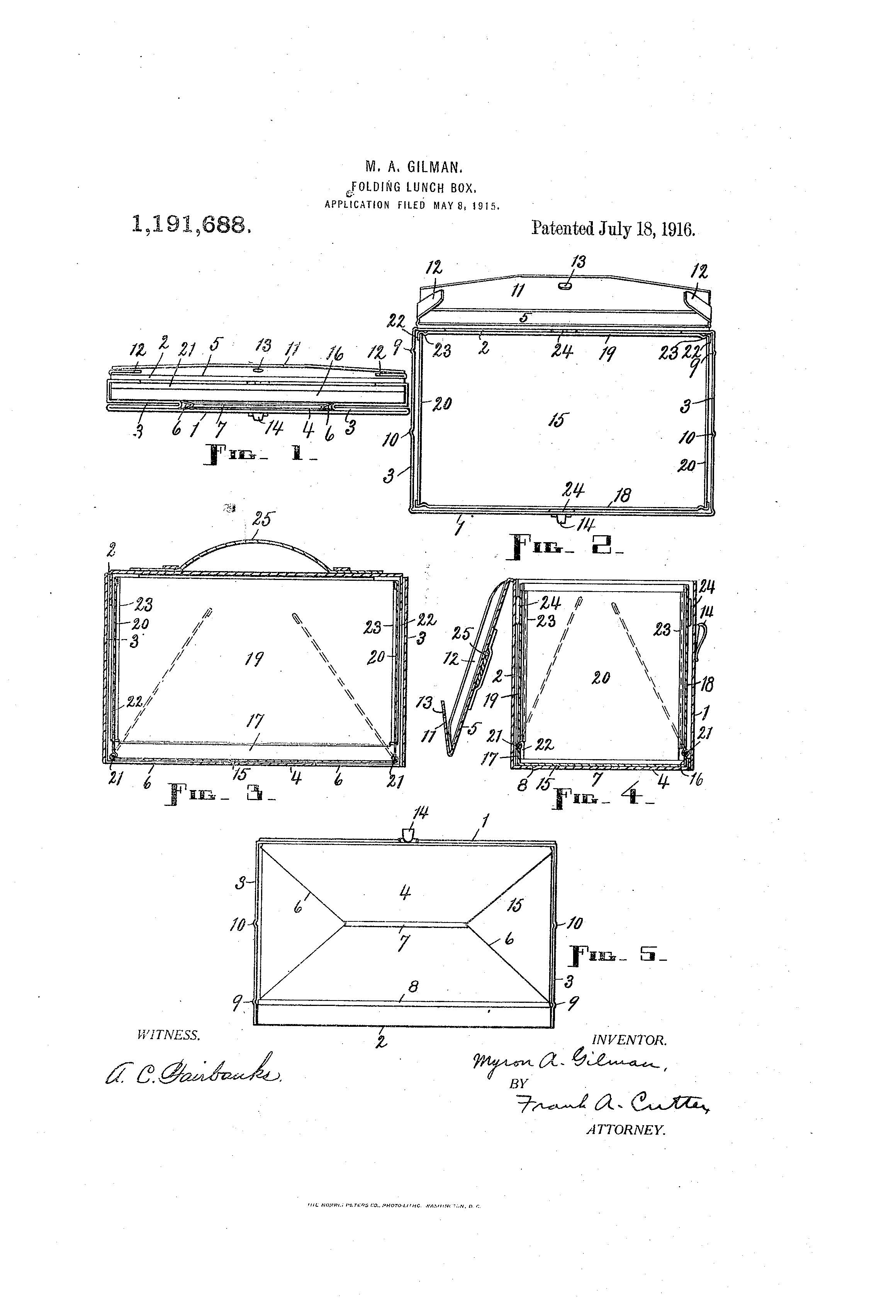
Patent of the Day: Electrical Generator
Suiter Swantz IP takes a look back at past inventions and inventors with our Patent of the Day.
On this day in 1883, Thomas A. Edison was granted U.S. Patent No. 281,351 for an ELECTRICAL GENERATOR.
An excerpt from the patent states:
The object I have in view is an arrangement and construction of electrical generators and operating steam-engines suitable for use in a central-station plant for supplying electricity to conductors of a system of general distribution, wherein a continuous and constant pressure is maintained on the mains or in other locations where two or more generators are employed, feeding separately into the same circuit. For such a plant I provide separate and independent high-speed and high-pressure steam-engines for operating the dynamo or magneto electric machines, the advantages possessed by this construction over the use of a large low-speed and low-pressure engine for running all of the machines being of vital importance in a general system of electrical distribution. There is greater economy in running generators by separate high-speed engines, since the number of engines in operation can be changed as required by the work to be done or the number of translating devices in circuit. To get a certain speed with a large low-speed engine a definite boiler-pressure has to be maintained, no matter how small the load upon the engine may be; hence there is great loss of power when the load is small, which loss increases largely as the load is decreased below the point of greatest economy. With the large low-speed engine, when the load is small, the friction becomes an important factor in the work of the engine, and the economy is greatly lessened. These difficulties are not met with when separate high-speed engines are used, since the engines can be thrown out of operation as the load decreases, and the engines left running be worked with good economy. The boilers (of which there would be a number, preferably the same number as the engines) can be thrown out of operation; and hence the boilers can also be worked in the most economical way. With the large low-speed engine an extra engine of equal power would have to be provided for operating the machines in case the first engine should break down or had to be stopped for repairs, cleaning, or for other purposes. This makes it necessary to have double the engine capacity required for running the machines, making the investment for engines larger than when separate engines are used, since with the separate engines I have found that one extra or spare engine in every six is sufficient, making the reserve capacity only one-sixth the entire capacity, and this proportion might be still further reduced. I addition, with the large engine, the breaking down of such engine would cause the total extinguishing of the lamps for a time until the reserve engine could be started; but with a number of separate engines, when one breaks down, the load is take by the other engines and the lamps are not extinguished, but only a momentary drop in the candle-power occurs, which is instantly corrected by the regulation of the generators in the manner hereinafter stated. The wear upon the separate engines is also less, since they will be thrown out of operation a much greater proportion of the time than the large engine. A most important commercial advantage is the large saving in the investment for real estate for a central-station plant, it being possible to place the separate engines with the small reserve power in much less space than is required by the two large engines, with the necessary shafting, belting, clutches, &c.
Suiter Swantz IP is a full-service intellectual property law firm, based in Omaha, NE, serving all of Nebraska, Iowa and South Dakota. If you have any intellectual property questions or need assistance with any patent, trademark or copyright matters and would like to speak to one of our patent attorneys please feel free to contact us.
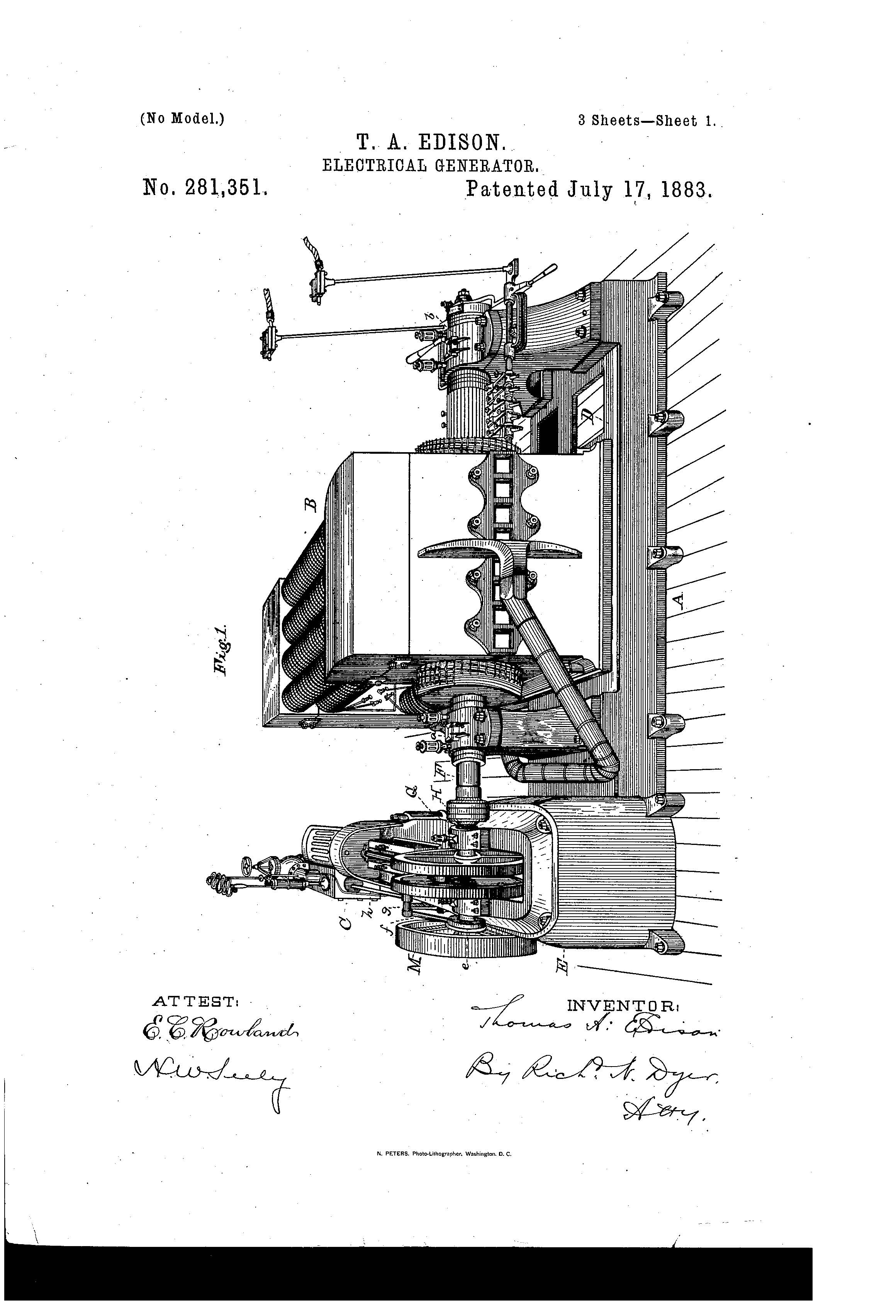
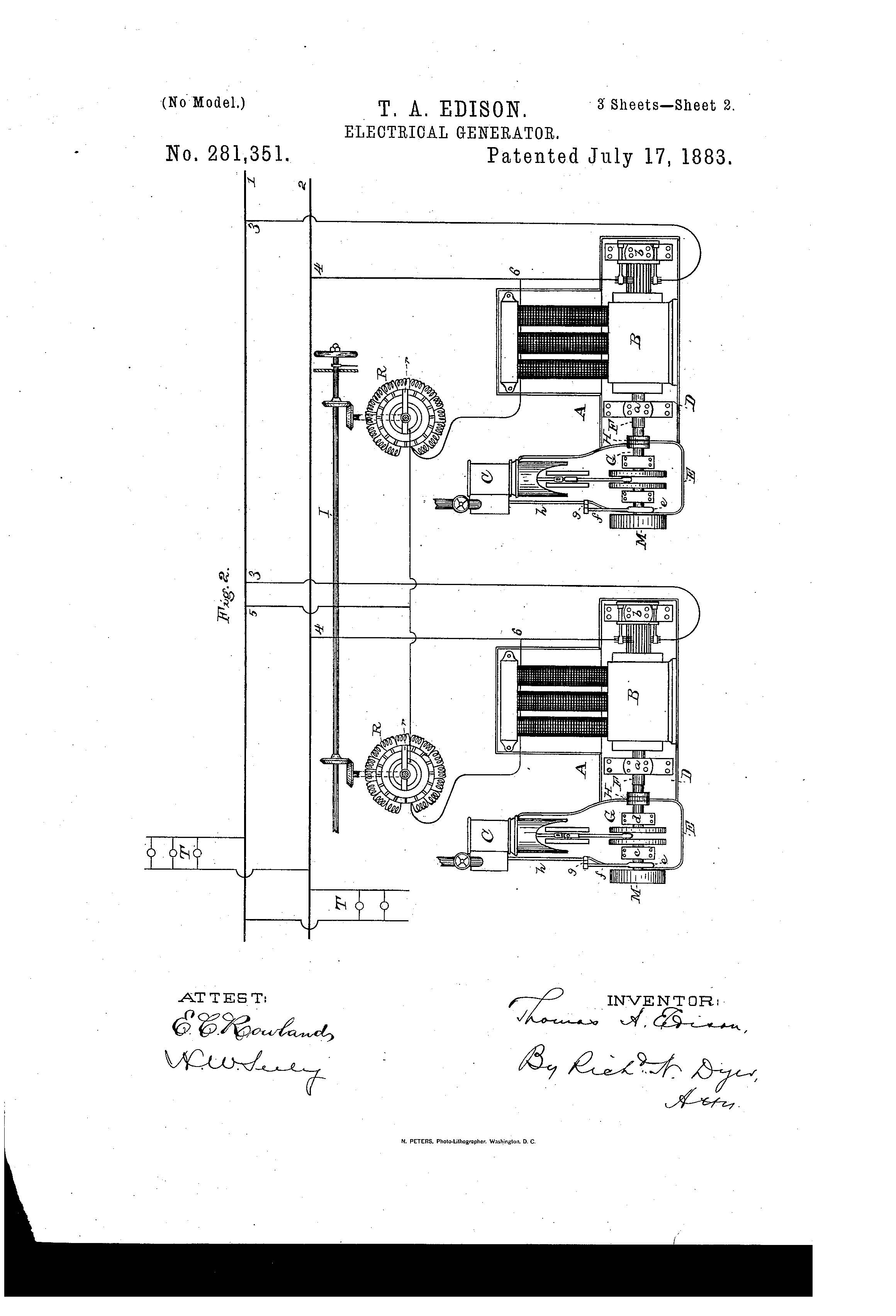
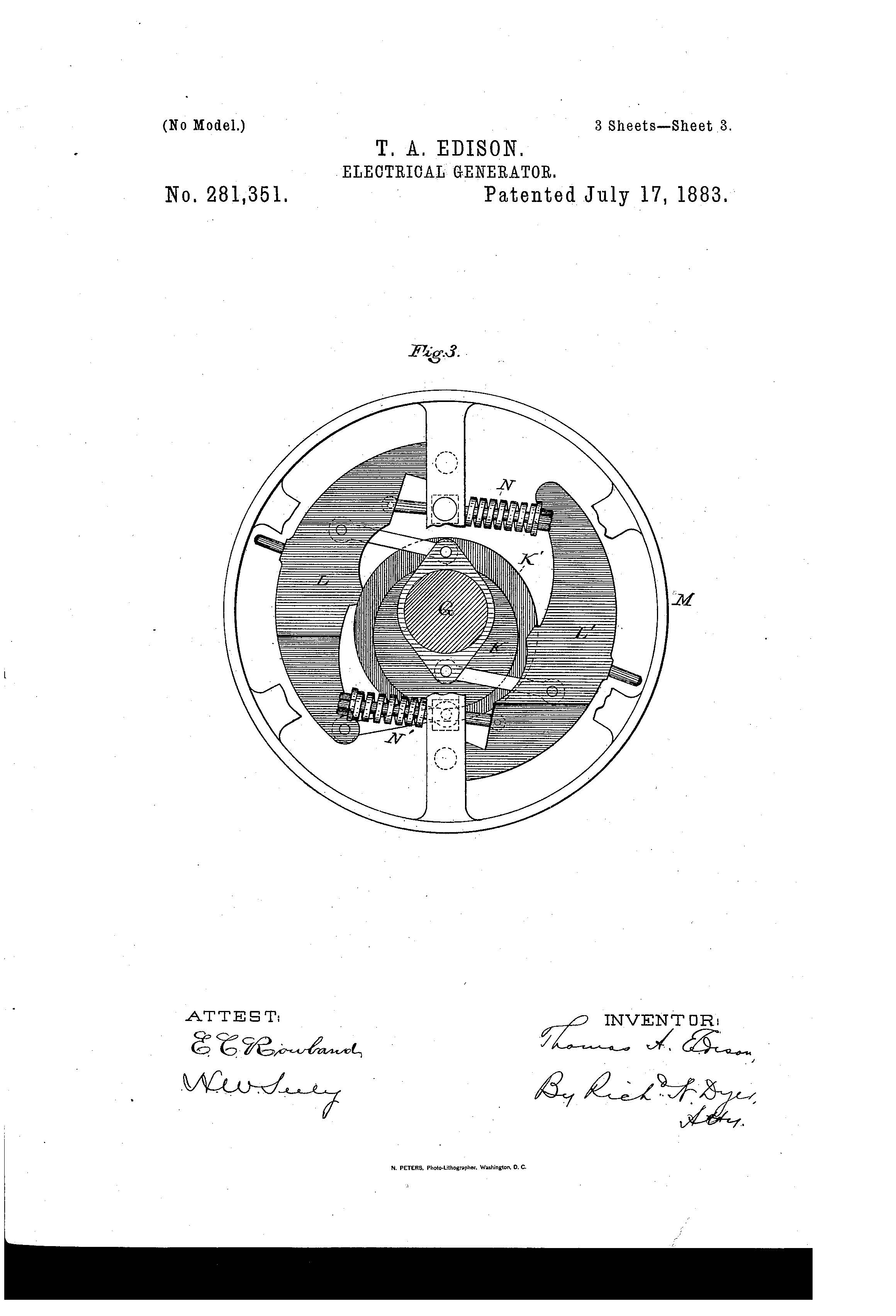
STRONGER Patents Act of 2017 Introduced
In June of 2017, Senator Chris Coons (D-Del.) introduced the Support Technology & Research for Our Nation’s Growth and Economic Resilience Act (the STRONGER Patents Act), legislation which is intended to make it easier and more affordable for patent holders to enforce the patents they have worked hard for.
Coons introduced the STRONG Patents Act last year, which was meant to create a more “fair and efficient” patent process. The STRONGER Patents Act is designed to update and expand upon the previous STRONG Patents Act, and is already making waves in the legal community.
One of the primary goals of the STRONGER Patents Act is to allow for patents to be treated as any other property by allowing patent owners to file protective injunctions during and after court proceedings. Further, by limiting repeat challenges, the Act looks to ensure fairness in Patent Office administrative challenges for all parties involved. Other goals of the Act aim to help protect small business owners from abusive patent demand letters and to ensure patent application fees remain at the United States Patent and Trademark Office (USPTO). By keeping patent application fees in the USPTO’s pocket, rather than in the hands of other government agencies, the Act looks to ensure timely, high-quality patents.
“We must work together to ensure that the patent laws keep up with the innovators, so their ideas and businesses can fuel the American economy for generations to come. This means working to ensure that a patent continues to play its historic role in enabling inventors and small businesses to get funding and protect their ideas from being copied by larger corporate infringers,” said Senator Coons.
There have been multiple Supreme Court and legislative changes over the past ten years that many feel have resulted in weakening the patent system. The United States used to be ranked first in the world for innovation and protection of intellectual property. However, partially due to the recent Supreme Court cases, foreign competitors have surpassed the U.S. in these categories. According to the U.S. Chamber of Commerce’s international ranking of patent system strength, the UK and Germany are quickly rising to the top of the list, while the United States has markedly fallen to tenth place. “The STRONGER Patents Act says ‘enough is enough’ and ensures that patent rights are protected as a fundamental underpinning of our innovation economy.”
Not only do patents help to drive innovation, they also serve to stimulate economic growth and provide jobs for thousands of United States citizens. “Patent-intensive industries create high-paying jobs that have a wage premium of 75%, and the U.S. currently has a trade surplus of about $85 billion due to the licensing of IP rights.” Playing such a vital role in the nation’s economy, the weakening of the patent system could prove have long term ramifications.
Patents also play a vital role in the startup community, particularly to tech-intensive startups. “Research shows that if a startup receives a patent, its chance of securing venture capital increases over 50% and it is likely to have better growth in employment and sales.” By addressing the declining United States patent system, the STRONGER Act seeks to strengthen the patent system as a whole, and to foster an environment where startup companies can continue to thrive.
As with all things politics, there are those with opinions on both sides of the issue. However, the STRONGER Act has largely been met with strong bipartisan support. Senator Coons said it best when he stated “Supporting American inventors is not a partisan issue...It is in our best interest both nationally and globally to ensure that our patent system works for everyone.”
Suiter Swantz IP is a full-service intellectual property law firm based in Omaha, NE, serving all of Nebraska, Iowa, and South Dakota. If you have any intellectual property questions or need assistance with any patent, trademark, or copyright matters and would like to speak to one of our patent attorneys please feel free to contact us.
Patent of the Day: Knitting Machine
Suiter Swantz IP takes a look back at past inventions and inventors with our Patent of the Day.
On this day in 1909, Louis L. Wilson and Exilias Paquette was granted U.S. Patent No. 928,165 for a KNITTING MACHINE.
An excerpt from the patent states:
The invention relates to that class of knitting machines in which the needles are mounted in a circular series, and are operated upon by cams and controlling devices arranged about the needles, relative movement between the needles and the needle-operating cams and devices being produced by rotary and reciprocatory movements of either the needle cylinder or the support or cylinder on which the needle-operating cams and devices are mounted.
The object of the invention is to effect certain improvements in the construction and operation of circular knitting machines, particularly of the latch-needle type, used for knitting stockings, by which the product of such machines may be modified and improved and the operation of the machines rendered more rapid.
Certain features of the invention are adapted particularly to enable the production upon a circular knitting machine of stockings of the kind in which the leg is knit of circular courses while the foot consists of two separate yarns of different colors forming the top of the foot and the sole respectively.
Suiter Swantz IP is a full-service intellectual property law firm, based in Omaha, NE, serving all of Nebraska, Iowa and South Dakota. If you have any intellectual property questions or need assistance with any patent, trademark or copyright matters and would like to speak to one of our patent attorneys please feel free to contact us.
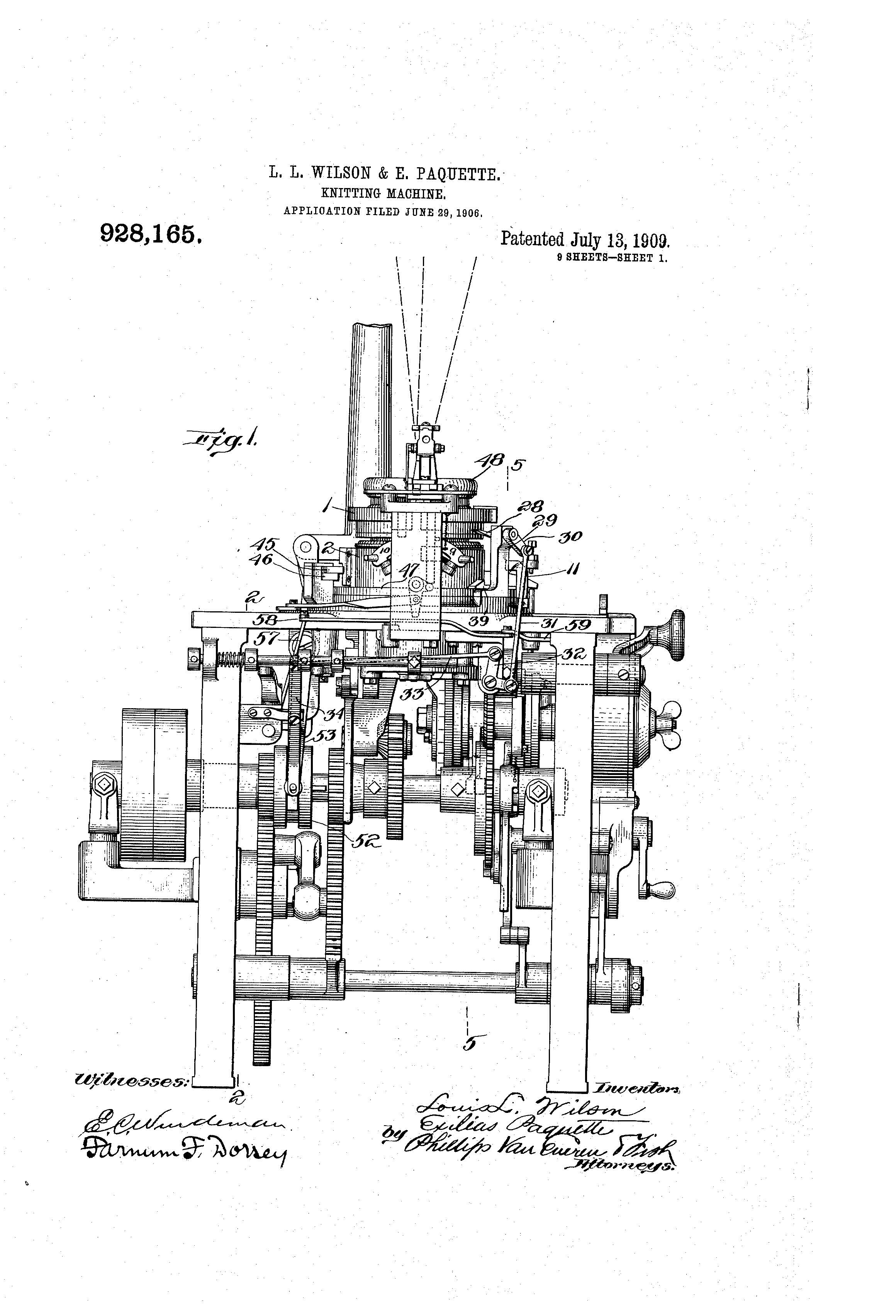
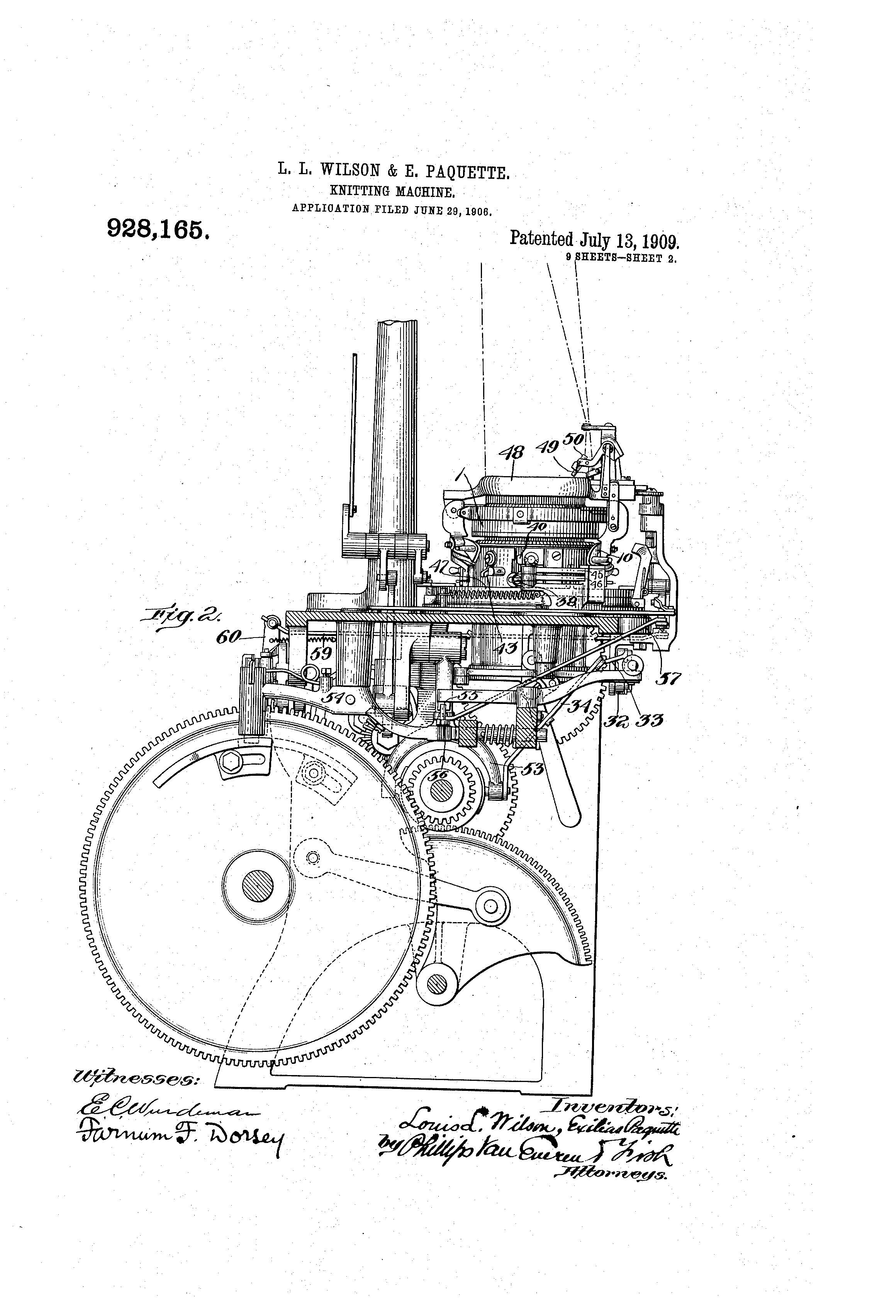
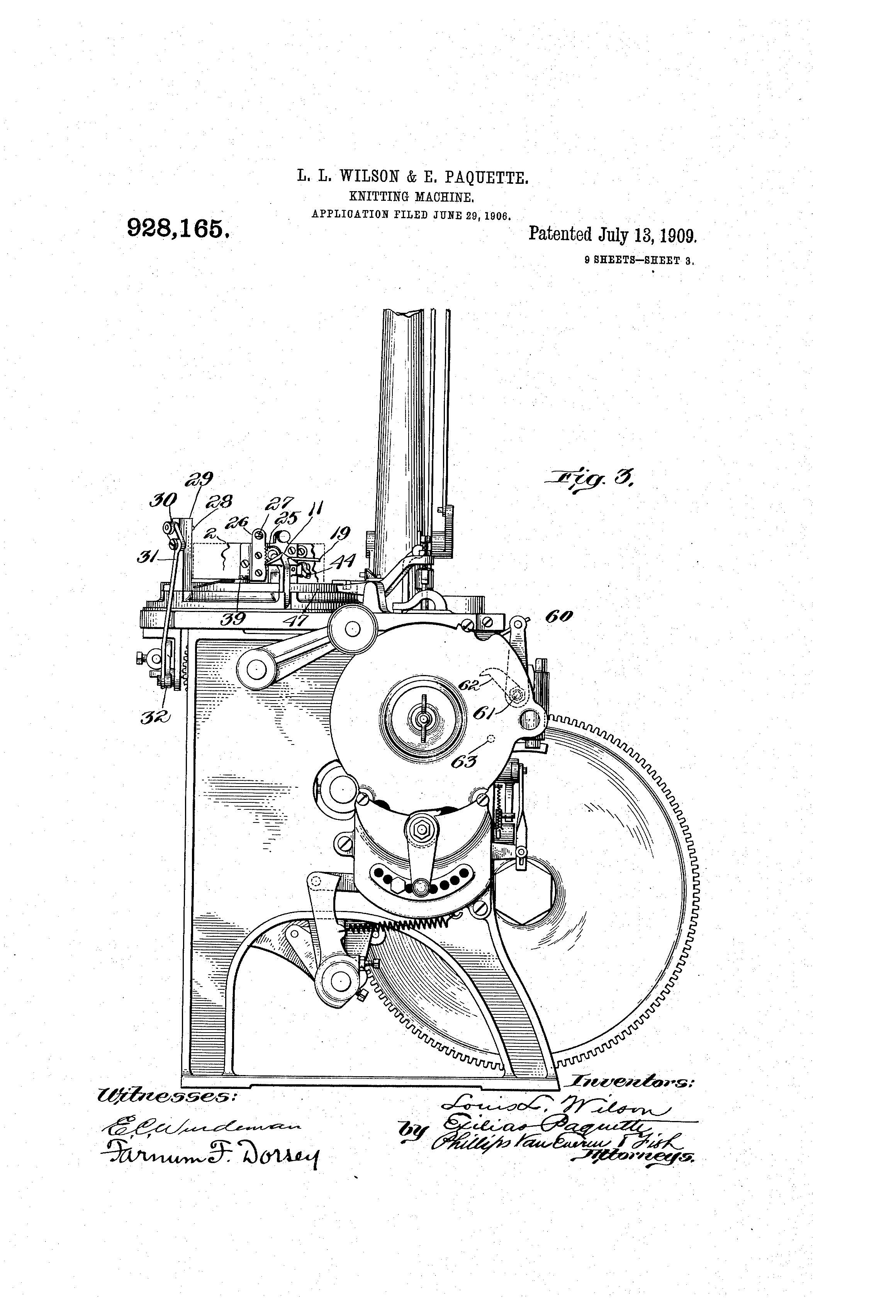
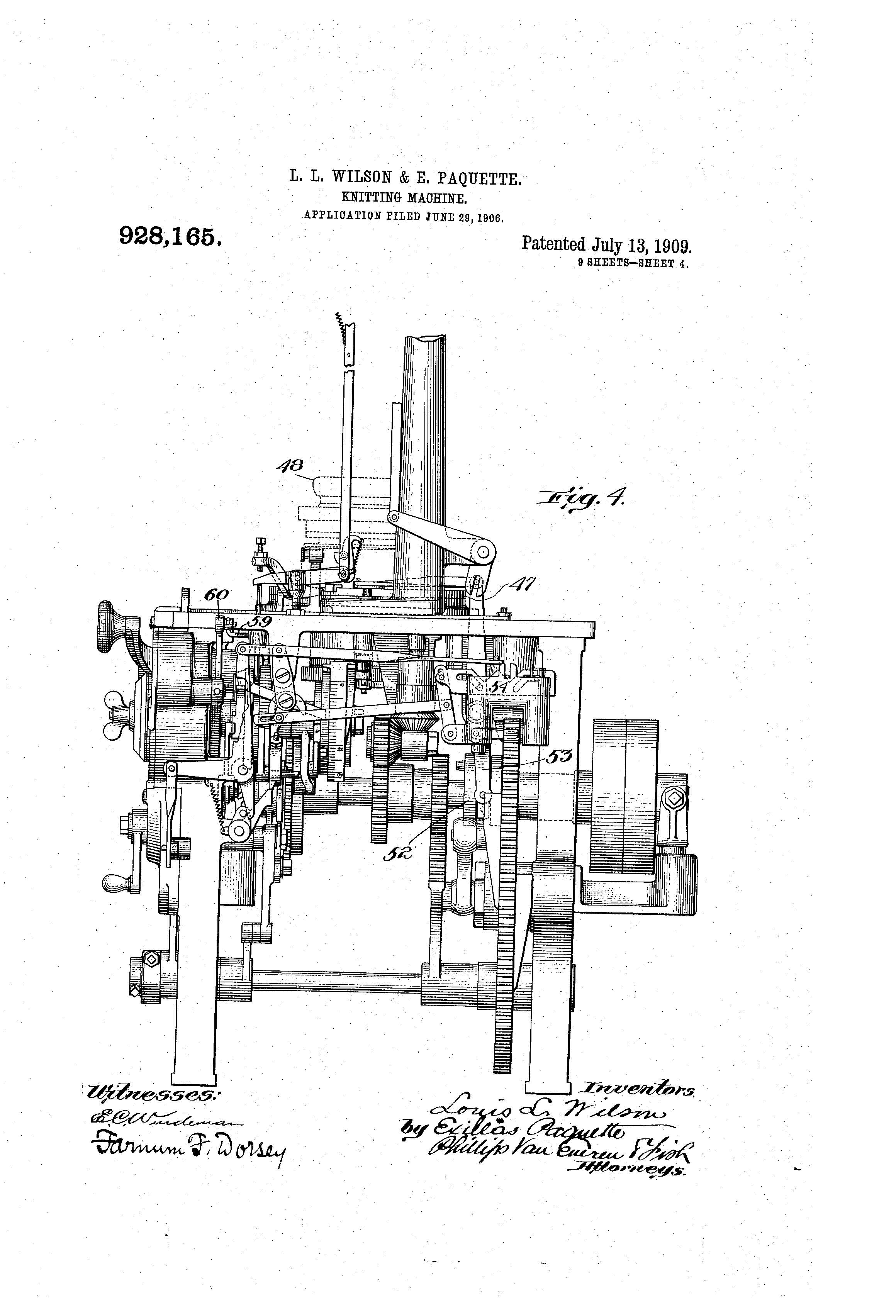
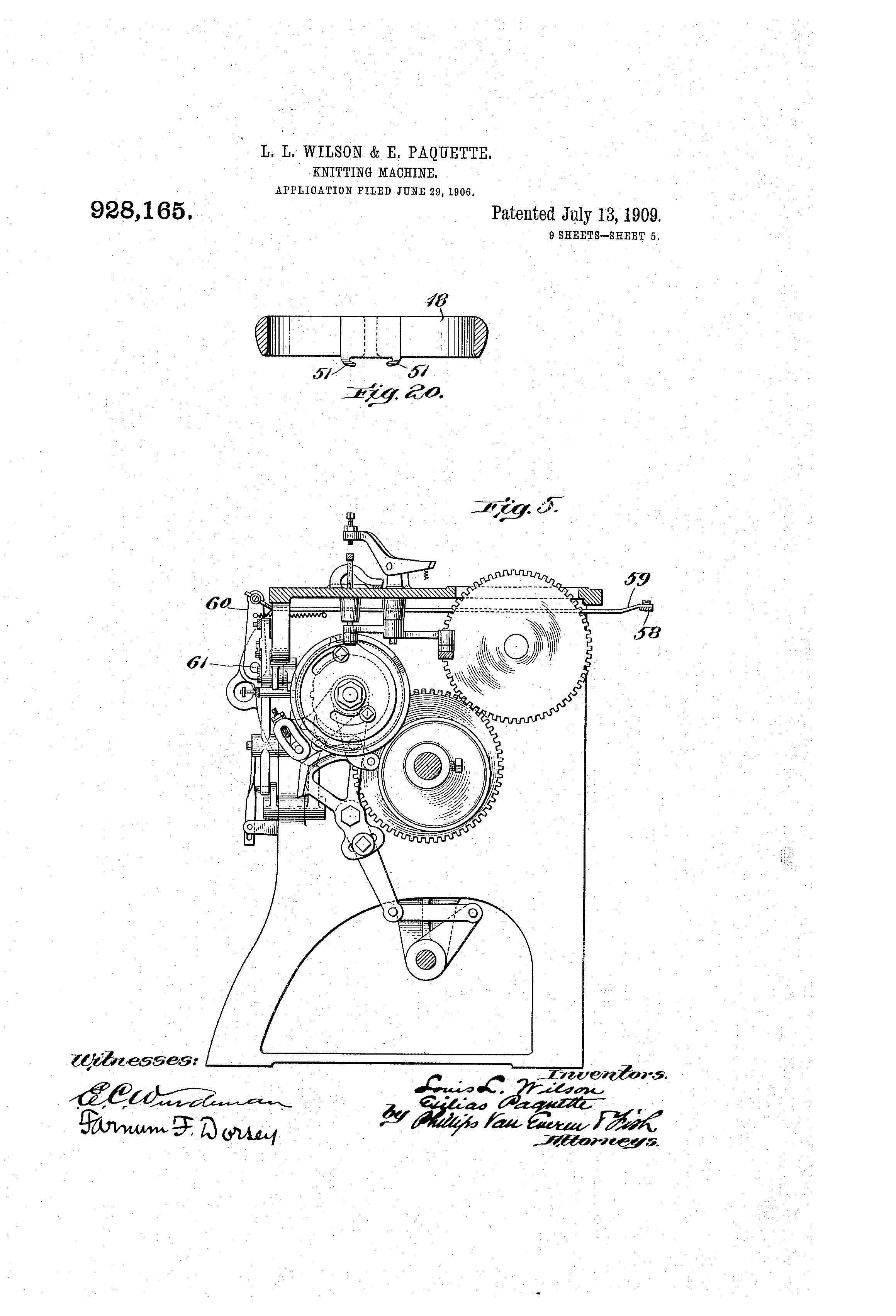
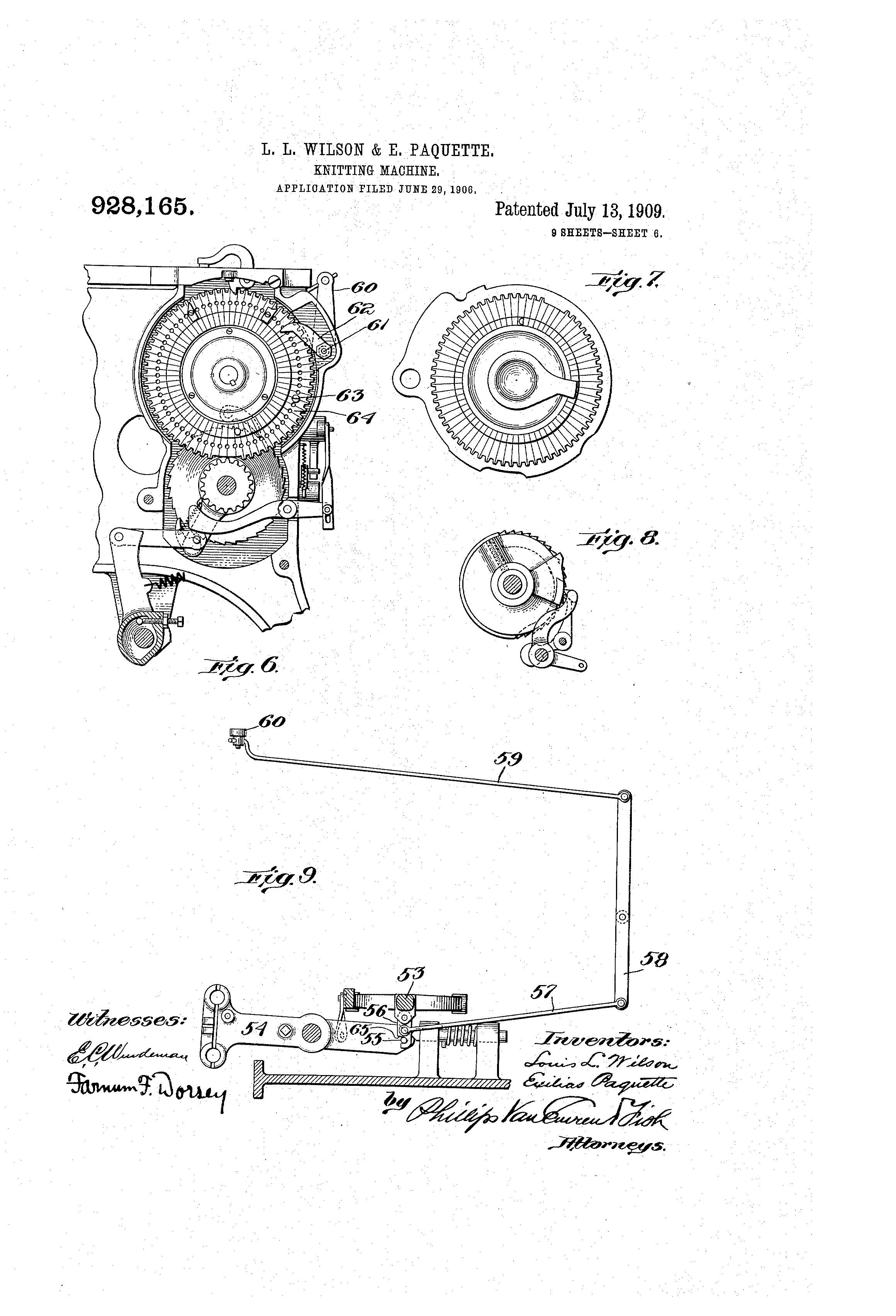
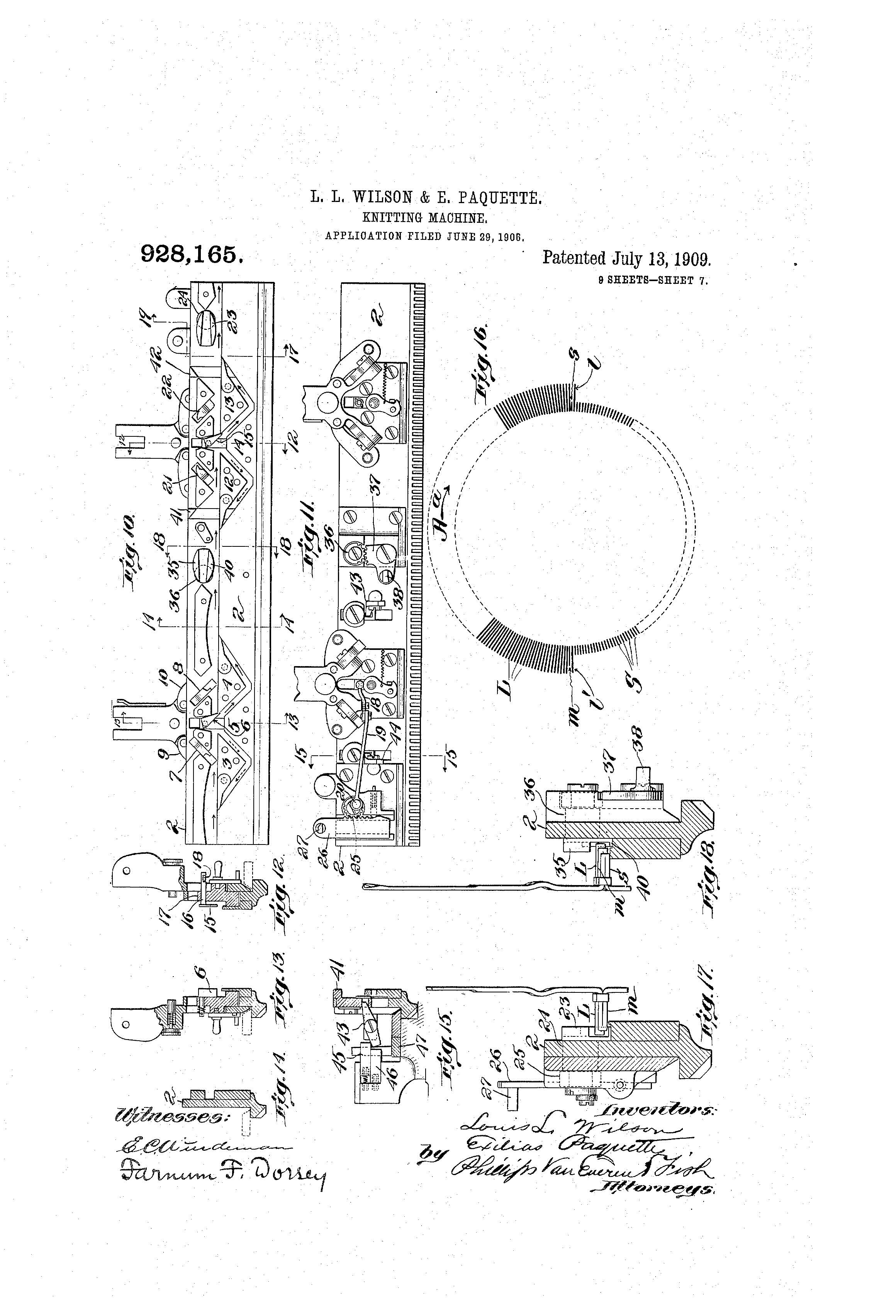

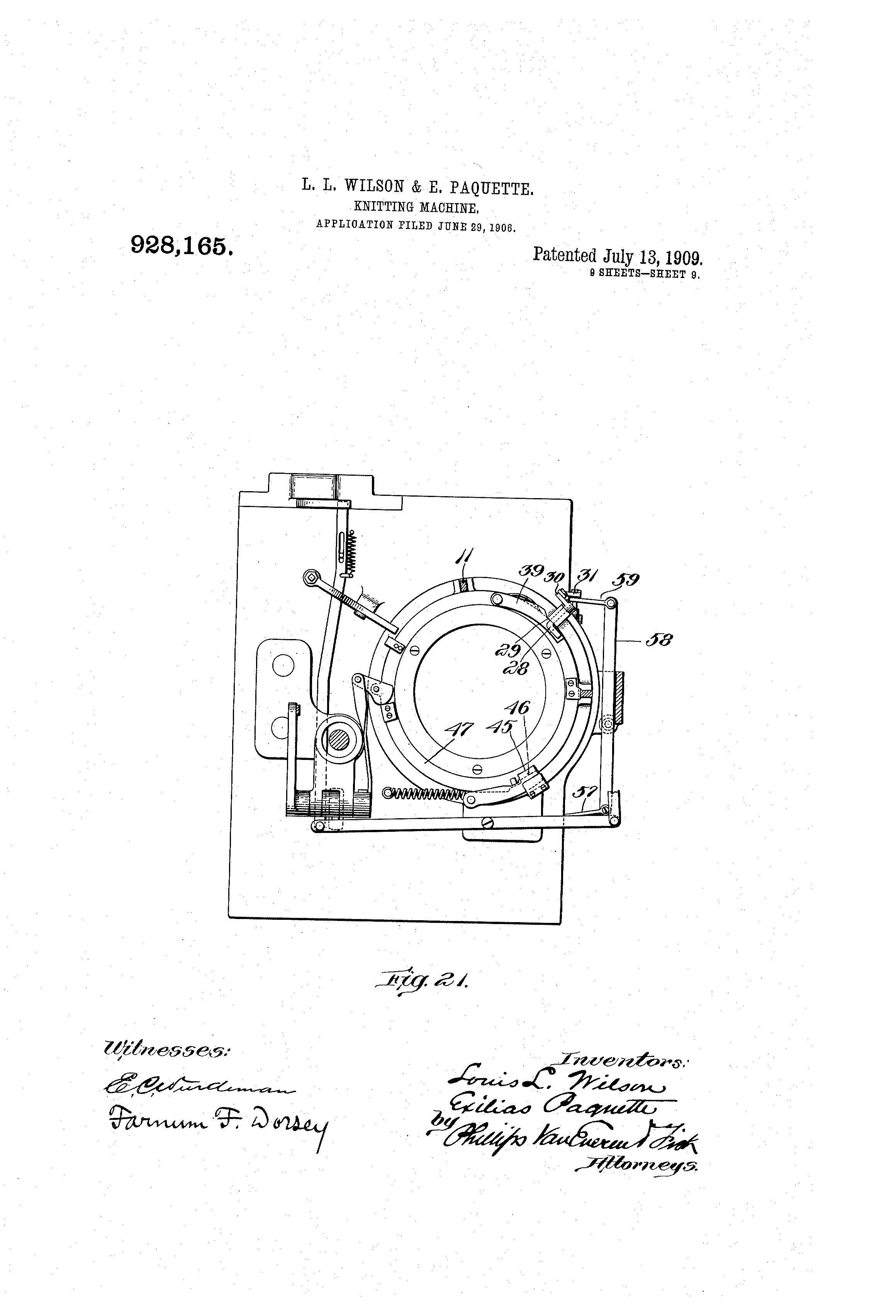
Patent of the Day: Baseball Cleat
Suiter Swantz IP takes a look back at past inventions and inventors with our Patent of the Day.
On this day in 1932, George W. Harper was granted U.S. Patent No. 1,867,219 for a BASEBALL CLEAT.
An excerpt from the patent states:
This invention relates to cleats for athletic shoes, especially the chisel type cleat used on baseball shoes, and has for its object to provide means for securing the cleats to the shoes in a manner to prolong the life of the shoe and distribute sole flexibility so as to facilitate running and walking. Another object is to secure increased comfort to the wearer. The usual type of chisel cleats for baseball shoes stiffens the ball portion of the sole causing excessive bending of the sole just behind the group of cleats during use, with the result that this localized flexure causes the sole to crack. Under this invention meas are provided to overcome this disadvantage.
According to this invention sole stiffening means extend rearwardly from the group of cleats so as to avoid excessive flexure and cracking of the sole. In one embodiment the toe cleat is spaced from the angularly disposed pair of ball cleats so that flexure of the sole may occur within the group of cleats. With the rear of the ball portion stiffened and the sole able to flex transversely within the group of cleats, there is a tendency for a runner to be raised on his toes by this construction to increase his speed. To increase comfort the sole stiffening means is curved to give a permanent convexity to the sole. The heel cleats are connected so as to leave the central portion of the group open permitting the leather to sink into the opening to a small extent with use, thus providing a comfortable depression for the heel bone.
Suiter Swantz IP is a full-service intellectual property law firm, based in Omaha, NE, serving all of Nebraska, Iowa and South Dakota. If you have any intellectual property questions or need assistance with any patent, trademark or copyright matters and would like to speak to one of our patent attorneys please feel free to contact us.
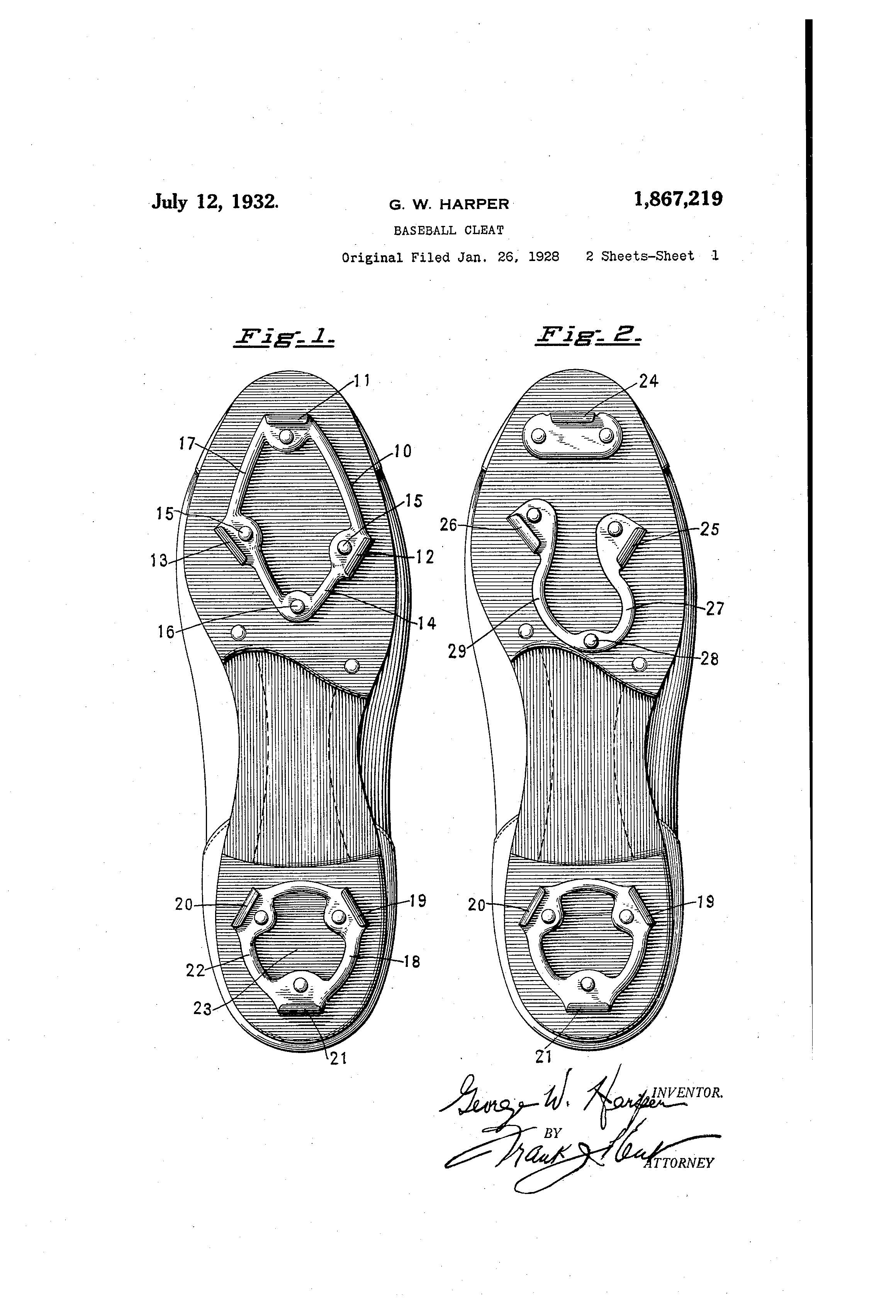
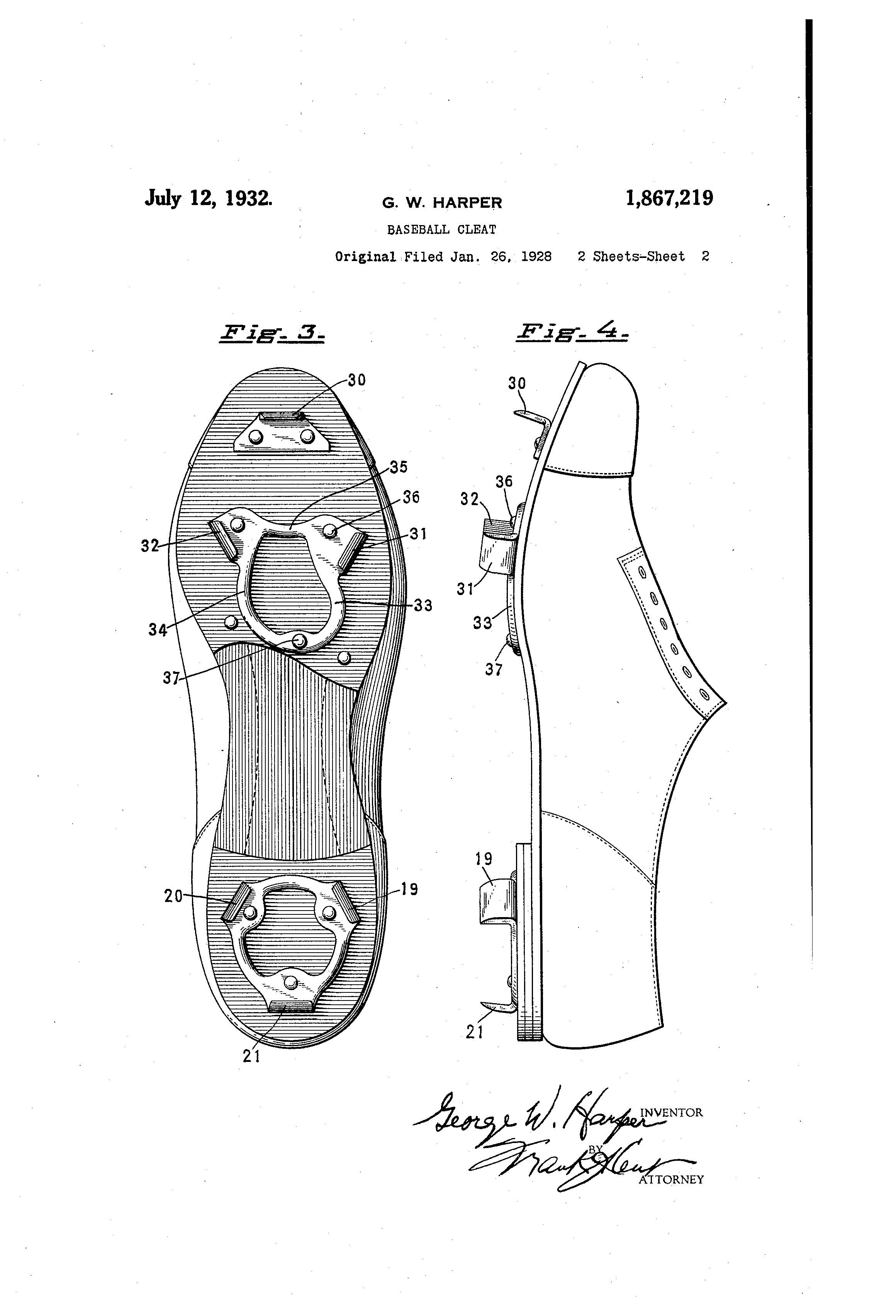
Patent of the Day: Noodle Making Machine
Suiter Swantz IP takes a look back at past inventions and inventors with our Patent of the Day.
On this day in 1939, Henry Chan Mun was granted U.S. Patent No. 2,165,718 for a NOODLE MAKING MACHINE.
An excerpt from the patent states:
This invention relates to noodle making machines, or the like, and it consists of the combinations, constructions, and arrangements hereinafter to be described and claimed.
Noodle making process requires various steps which heretofore were formed by separate machines. The latter are of considerable size and expensive and are exclusively used by concerns which produce great quantities of noodles daily. A small producer manufactures his supply manually or with the assistance of very primitive implements such as a pan, board, beater, knife, etc. It is the purpose of this invention to produce a small, compact and inexpensive noodle making machine capable of producing twenty-five to fifty pounds of noodles per day.
Another object of my invention is to produce a noodle making machine which mixes the dough, flattens and reduces it to uniform thickness, cuts the strips into predetermined lengths.
Still another object of my invention is to provide a machine of the type described which is simple in construction and operation, durable and efficient for the purpose intended.
Suiter Swantz IP is a full-service intellectual property law firm, based in Omaha, NE, serving all of Nebraska, Iowa and South Dakota. If you have any intellectual property questions or need assistance with any patent, trademark or copyright matters and would like to speak to one of our patent attorneys please feel free to contact us.
